#WHY DID THE COLOR HAVE TO SATURATE HIGHLY WHEN OUT OF THE PROCESS
Explore tagged Tumblr posts
Text
Bro wanna splay the gore of their profane form across the stars so badly it makes him look stupid


Roblox pixel art is hard to grasp like, GIVE ME BACK MY LAYERS AND ALPHA LOCK
((Originally made on august 22, 1 AM))
#ultrakill#gabriel ultrakill#v1 ultrakill#Roblox#pixel art#roblox draw and donate#GEHRGRGRGRR#I HATE THAT MACHINE#WHY DID THE COLOR HAVE TO SATURATE HIGHLY WHEN OUT OF THE PROCESS
38 notes
·
View notes
Note
hey balu, do you know how to recolor skin / how a coloring psd works for that? like for a character that's pale and not the shade they should be ( cough cough natlan ) asking bc I want to that but idk how
Hiya, anon! I can explain how I personally do it, but here's a huuuuuuge disclaimer: I'm colourblind, so I heavily rely on colour wheel pointers. Throughout this tutorial, you'll see me constantly comparing where the pointer is and trying to use my somewhat limited knowledge of colour theory. I'm sure other creators have other ways to do this that are much simpler and/or more effective; you should look for and check out other tutorials here on Tumblr, YouTube, or Twitter!
Due to the limited previews of images on Tumblr, you can also open the images on new tabs to see more details.
For religious and political reasons, I will not use a Natlan character as an example. Instead, I'll use Candace (also from Genshin Impact) as our muse. Specifically, I will use her character card art image, which can be found on the Genshin Impact fandom wiki. The image quality is not so great, so that's why we'll see some bleeding pixels here and there. Dealing with those is another tutorial altogether. Also, if you meant an absolutely pale character (with littler to no melanin), that would be another tutorial, too. So, I'll be sticking with these examples and explanations here! This can give you a starting point.
In this tutorial, we will go from this before (left) to this after (right):

Also, I'd like to point out that these steps are for this specific picture/character. Though the same logic can be applied to other characters and images, it's imperative to remember, especially when you're starting your editing adventures, that there is no fool-proof and 100% universal PSD. I'm just explaining the logic behind how a colouring PSD works and some of my mental processes behind it.
Please consider reblogging, liking this post, and/or supporting me on ko-fi if this helped you! That way, I can keep bringing you tutorials like this faster and more effectively. ~
Now, let's begin!

First, we must notice that skin colours (even paler ones) are shade variations of yellows and reds. If we check the hex code colour/colour pointer on the colour wheel, we will see that Candace's skin colour is at the intersection between red and yellow, and is on the lighter/less saturated part.

Here, I am deepening/saturating the blues of her clothes by creating a Hue/Saturation layer, changing from Master > Blues and adjusting the Hue and Saturation values. Colour theory basics: opposing colours on the colour wheels will give a more significant idea of contrast; the bluer colours will appear colder, and the warmer colours will appear hotter and, therefore, more saturated.

In this second step, I am creating a Selective Colour layer, focusing on the Reds. I want this to be highly reddish for now, so I'm lowering the Cyans to the minimum values I can. Notice how the colour wheel pointers went down, meaning we are in a redder, more saturated and more precise zone. The darker the skin, the redder its colours will be in pictures.

Thirdly, I am now creating a Colour Balance layer. Since I want to adjust the warmer colours (e.g., Reds), I am adding more reds, magentas, and yellows.

The exact process I did for Candace's clothes, I'll do for her accessories. Her accessories blended too much with her skin tone (hex code-wise and I imagine that for the normal eye, too). So, to make the yellows on her accessories pop and be more different from her skin, I created yet another Hue/Saturation layer and changed from Master > Yellows, altering the Hues, Saturation and Lightness values.

Now that we have the image's primary colours (blues, reds, yellows) separated, it is time to deepen/saturate the reds. So here, I made another Selective Colour layer, also focusing on the Reds. Notice that now I'm also increasing the Cyan values. Why? Because Cyans make the reds look darker, and I want exactly that. So everything will increase in value.

To further deepen these colours, I created a Curves Layer and tweaked each RGB curve. I made the blues lighter; meanwhile, the greens and reds went darker. Again, colour theory! Notice on the colour wheel that her skin is extremely red and saturated. This is precisely what I want. Why? Well...

... Because now, by using a Selective Colour layer again, I can make her skin magentaish. Pure magentas are rare in pictures, even fantasy/2D characters. Generally, you will find variations of purples, pinks or reds, but magentas are more difficult to find. Therefore, they're easier to work with/edit. Even if the character had magenta colours, we could've isolated them beforehand, too. This step guarantees that my PSD will solely focus on her skin tone, basically.

Our final step is to create another Hue/Saturation layer and change the setting from Master > Magentas. We will decrease the Saturation and Lightness values and slide the Hue bar to the right. And now, check the colour wheel: it's a beautiful dark brown! It's popping a lot against the yellows and blues. ~
This is where we started vs where we finished!

So there you have it! A speedy but hopefully informative tutorial on how colouring PSD works and how you can quickly love your characters a bit more when doing edits and graphics for them!
Again, please consider reblogging, liking this post, and/or supporting me on ko-fi if this helped you! That way, I can keep bringing you tutorials like this faster and more effectively. ~
If you have any questions, please let me know!
#♡: tutorials! *#gfx tutorial#graphics tutorial#graphic tutorial#gfxs tutorial#resources#rolep#ps tutorial#ps tutorials#photoshop#photoshop tutorial#photoshop resources
33 notes
·
View notes
Note
God, that post about movies being so dark that you literally can't see what's happening just reminds me of all those "realism" reshade mods that people make for every game where the saturation is gutted and contrast is cranked so hard that you can't even see your character's hand, let alone something that's 5 feet in front of you
Like, guys, nighttime doesn't need to be darker than satan's anus, horror and tension can exist without relying on sensory deprivation, skittish camerawork, and jump scares, and there's this magical celestial body called the fucking moon which literally reflects sunlight back at the planet to indirectly light up most nights (and I guarantee, like, 99% of fictional planets also have moons)
Need to give these people some 30-grit sandpaper and call it toilet paper, I swear they wouldn't know the difference
If we're talking games, the arrival of HDR did that more than anything. Devs got seduced by those high highs and low lows in light and shadow and started hurriedly implementing them, sometimes at the cost of legibility, and sometimes not. There's lots of good and bad examples but at the end of the day it's up to your goals on how it will affect both sides of the diegesis (is it important to see the face of this cliff in nighttime? if it is, is it also important to see the parts of it that you can climb?), and you will certainly get modders who will push things to even more naturalistic extremes without rhyme or reason. Them's the breaks I guess! But I think it's fine to use sensory deprivation and painting with light and shadow as essential building blocks if your game is something that relies on mood and tension a lot; it may feel played out, but cinematic language is both an important tool and a good shorthand in establishing a connection with viewers/players. It's always about deftness of execution, and being intentional with your lack of legibility whenever you do have it. It gets much harder when you're talking open world games with that slippery slope of art direction and global illumination constantly playing tug-of-war, but I think we're slowly building necessary tools to mitigate that as well. I keep bringing up the witcher 3 as a great example of that.
And if we're talking movies as I was then it's a whole different ballgame. Photography at nighttime is tricky as hell and the reason I mentioned Peele was specifically because him and his cinematographer (looked up just now; Hoyte van Hoytema) literally developed a new way to shoot night scenes in broad daylight by processing and using infrared data to retain visual fidelity after color grading, and that is why his night scenes are so legible at long distances yet tangibly dark and moody. It is a great way to retain naturalistic flavor while sacrificing minimal wiggle room for art direction. Miller's Fury Road, on the other hand, shot at noon and did very little to minimize the soft lightboxing effect from the sun; it is a highly stylized film with an even more heightened visual flair and it felt like a perfect way to depict it during the night, with an almost monochromatic edge. Again; intentionality wins in all of these cases. You light for the story you're telling.
Thank god we don't have people modding films. Actually, you know what, don't even tell me. I'm sure there's a rabbit hole here entirely not worth exploring.
11 notes
·
View notes
Note
not sure if you’ve answered this before, but what’s your process look like when you make an amv? i’m just curious and in constant awe of ppl who can make videos like you do :)
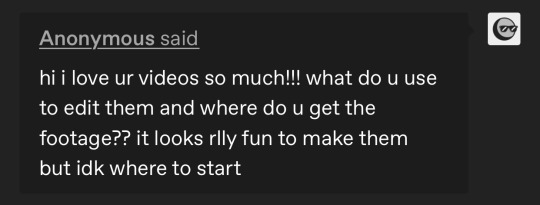

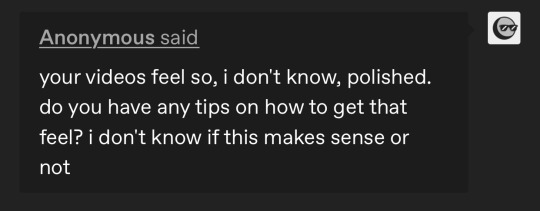
hello all!!! i have answered this before and i have a vid help tag with other asks i’ve gotten about stuff like this! but i’ve gotten several more messages along these lines so i’m just going to answer a bunch of them together (under a cut since i love to ramble about editing lol). i do just wanna say i’m definitely not the authority on video editing and obv everyone has their own techniques!
edit: i just finished typing all this up and it’s SO long so sorry in advance LMAO god bless anyone who reads this entire thing
so i work in news tv and we have a very specific workflow for writing scripts, sourcing video, producing, and editing. i’ve just applied that to making amvs! for every video i make, i copy the song lyrics into a google doc and adjust them to match the song i’ve cut (i often will trim songs for time and/or content purposes). then i start planning! i’ll mark down what clip i want to use for each lyric next to that line, and any sound bites i want to use (with episode numbers!). i’ll color code between video and sound bites and lyrics, so my scripts end up looking something like this (for my honeybee amv):

doing the planning ahead of time makes everything much easier when it’s a video that spans the whole show or involves a lot of sourcing, like honeybee or sports analogies. that way when i get to the actual editing process, i already know what i’m going to do and have a game plan. for videos like happy ending or believe it or not, where i’m mainly just pulling from a few episodes, i can just plan it in my head as opposed to writing it all down, and produce as i edit. obviously i do make in-the-moment decisions while editing—sometimes a shot doesn’t work the way i thought it would, or i go where the video takes me—but planning ahead definitely helps. i know some people use spreadsheets as well, with columns for lyrics, video clips, and sound bites if applicable. once you find a system that works, it actually goes pretty quickly.
as for sourcing clips themselves/finding clips within episodes, i talked about that here and kind of here. the short version is that transcripts are a must, and the supernatural wiki is hugely helpful by cataloguing all the hugs, prayers, phone calls, etc. in the show. gifmakers that tag episode numbers on their posts are your friends. it gets easier the more video you make—that’s another huge reason i make the google docs for each video (even the ones i plan in my head, i end up going back and making a loose script with episode notes just for reference). if i can’t remember where something is but i know i used it in another video, i can easily reference past scripts!
i also cut all my videos in the same project in premiere pro, so i can flip between them easily. instead of checking a past script, i can just go to the video sequence itself and copy the clip i’m looking for! this was especially helpful when i match cut together the 5x18 and 4x22 wall slam shots for my bestie video, and then stole it from myself for honeybee hahaha. at any given time i have at least 8 sequences open:

because of the sheer volume of videos i make, it’s worth it for me to download the entire show—i have all 327 episodes in HD, plus deleted scenes. if you think you’re only going to make a few videos, i’d start with scene packs. you can usually just google “destiel [or whatever ship/character you’re looking for] scene packs” and there will be any number of ones you can download. if you need other specific scenes, you can always download/torrent individual episodes or screen record netflix (that’s what i did before i got HD download links). i’m happy to share my links if you DM, but be warned it’s a lot of disk space (about 500GB on my hard drive). someone also compiled every destiel scene, downloadable here.
having every episode already loaded in premiere for all my projects also makes it a lot easier to source clips. once i use a clip in a video, i’ll put a marker on the episode file, so that after a while i have most of the important scenes/lines marked to easily find them. to give you an idea, this is my episode file in premiere for 12x10 lily sunder has some regrets (markers at destiel scenes, the car fight, hot girl cas, etc.). markers are the green tabs along the bottom:
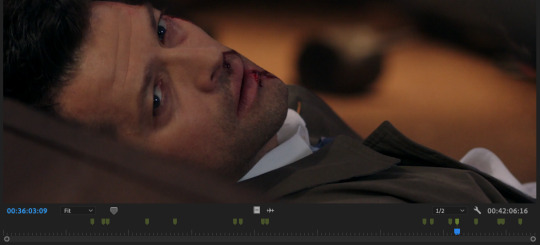
premiere also lets you color code and name markers, so ONE DAY i will go back and color code them all. the ones above are all the same color, but in a perfect world, i’d have a myraid—for destiel shots like hugs, touches, looks; for important pieces of dialogue; for action shots; etc. but for now this works ok for me, so that’s a project for another time!
between detailed scripts, one giant premiere project, markers, the wiki, and my own memory, i have so many points of reference that i can usually find any clip i need in about 2 minutes max. sound bites are often harder to start out, or tiny specific shots i haven’t used before, and that’s when i turn to tumblr gifsets or beloved mutuals to crowdsource. but if you’re as obsessive about marking/keeping neat scripts as i am, it gets easier and easier with every video you make. that’s part of why i’m able to cut videos together so quickly. (also i want to stress i do this for a living and have to produce/edit a new piece for my show every day so i’m used to it. and compared to constantly updating content/sources and news that changes every day, 327 highly documented episodes that never change are much easier to handle hahaha)
this is all great for me since i make so many videos and plan to continue doing so, but if you’re only making a few, this level of work isn’t worth it imo. really it’s all about developing a system that works for you. whatever you do with episodes/sourcing, though, i cannot recommend planning things out in a script ahead of time enough.
everything i just mentioned is producing, though. for the editing process, i usually do it in this order:
music first. any parts i want to cut, i make sure it all sounds smooth
then soundbites. i usually try to weave them into the lyrics—i have characters talk in breaks between lines or instrumental sections as much as possible. i’ll sometimes go so far as looped/extending an intsrumental part to make room for the soundbite i want there lol. if i do have dialogue over a line, i do the sound mixing/levels at this point as well to make sure everything is audible/one doesn’t overpower the other. (also i always include the video that goes with these bites when i drop them in, and decide later if i want to show the character speaking or have other clips cover the dialogue)
once i have all the audio locked in, then i bring in all my other video clips. sometimes i edit completely chronologically, sometimes jumping from section to section—it depends on the song or how i’m feeling
double check sound mixing. i usually listen to my videos through a few times, with headphones and without to make sure it’ll sound good no matter how people watch it
once i have picture and audio lock, i go through and color correct my clips. i’m basic and just use lumetri color in premiere, and usually just play with brightness, saturation, temperature, and tint until i like it
render and export! :)
i always have several audio tracks, but i try to keep my video tracks condensed. i’ll drop clips on a V2 level, and edit a section there, and drop the whole chunk down to V1 so i know it’s finished. that way when i leave and come back i can know where i left off/what’s done/etc. to give you an idea, this is the timeline for my what the hell video:

i always render as H.264 with high bitrate, and make sure to check “render at maximum depth” and “use maximum render quality” for the best quality. i’m sorry, but i don’t know what the equivalent options are in final cut, imovie, kdenlive, etc. i post on youtube mostly so i don’t have to sacrifice quality, but usually just using a lower bitrate will get you under the tumblr file size limit and it’ll still look good.
as for the anon who asked about “polishing”: first of all, thank you!! second of all, it’s in the details. all of this is a matter of taste and my own insanity, but here are some little things i always try to do:
after i color correct, i blur out any credits from the starts of episodes. i use gaussian blur for this, but really any blur tool works
as much as possible, i avoid clips where we see a character’s mouth move but don’t hear the words. in tv/film we call it “lip flap” and i just think it looks messy. also i’m trained to avoid it at all costs at work hahaha. it’s more for serious videos that this matters a lot to me (e.g. i think i did a really good job eliminating lip flap in my happy ending amv)—for comedy videos i don’t sweat it as much
i put audio fades on the start and end of every single audio clip i use, even if i don’t think i need it, to make sure everything sounds smooth
i use markers for timing, especially in action-y videos like what the hell. i’ll put a marker on the clip i’m using at the exact moment a punch lands, and in the song on the beat. if i have the magnet/snap in timeline tool on i can just easily snap them together instead of having to spend time finagling it
this is such a small thing but i dip/cut to black for a tiny bit at the start and end of every video. this way if i post with tumblr video player, there’s black between the loops, and it gives you a beat before the video restarts. i do this even on videos i post on youtube, just because i think it looks nicer/more professional
this is 1,500 words so i’m going to stop myself before i pull something. if you have follow-up questions feel free to ask and i’ll continue to add them to the vid help tag, but any more questions about sourcing clips or my process in general i’ll just link this post going forward. anyone who made it this far, i am sending to a telepathic kiss. thank you for reading and happy editing!
76 notes
·
View notes
Text
OOC commentary: vivid ponies
This is an OOC post, just as a little insight into my thought process, in case you were curious. there is no tl;dr, you can either read it or not, it doesn’t effect the story.
Folks rarely ask me about why I make things look the way they do. I just post these descriptions because it makes me feel like I’m contributing something more to the blog. MLP does a lovely job of re-envisioning classic mythology in a way that makes it work in their environment. The show tends to stick to Greek roots, but its deviated a few times (the Wendigo being a big one) and it often changes the nature of the legend itself, to allow it to mesh in Equestria. Sometimes the adaptations are small, like with the Hydra being a ‘thing that lives in a swamp’. other times, they completely re-write the myth, like they did with the Wendigo. Even Pegasus ponies are a deviation. Originally, there was only one winged horse, and its name was ‘Pegasus’.
Coatls have never been a ‘race’, traditionally. oh they’ve popped up countless times in more modern renditions, I know MTG uses them as a creature type, i think Ive seen them mentioned in various video games, but much like “Pegasus”, there was only one “Coatl”, and it wasn’t a racial title, it was the second half of his name. Pretty sure there were multiple “winged snakes” in Aztec mythology, they just didn’t have a proper title. But it kinda cuts down on the fun when you’ve only got the one of something, so I decided to branch them out a bit. Serpent bodytypes present a unique challenge when used in a dynamic world; they’re rather specialized toward one specific task. giving them wings grants me a little leeway when it comes to gesticulation, but it also begs the question of how they fly. By all rights, flapping those things would just result in their little tube bodies shaking up and down on the ground. But that gives us a new opportunity for lore.
The coatls in this universe produce lift without flapping. its a magical quality of their wings, which makes their feathers highly prized as a means of making heavy objects lighter. this can provide all sorts of opportunities for story, from barter to piracy to any number of other things, and gives the species an inherent need to be defensive. That feeds into their already edgy nature and gives me some extra dynamics to work with if i need a plothook that’s less dramatic than the Vivid situation.
Speaking of…
Someone is going to get on my case about the Lisa Frank coloring on the vivid ponies, and im going to giggle when it happens. Its quite deliberate, I wanted to make a creature that made your eyes bleed when you looked at it. It should almost be painful to behold, not in a garish sort of way, but in a saturated sort of way. The narrative idea behind a vivid pony is that all the restraints they’ve learned in life have been removed, and theyre left with raw potential. its a saturated, overflowing sort of power that moves like liquid and spills out over everything around it, providing strange and alien results. that takes a strange and alien design, but i still wanted it to be pony enough that it might somehow be recognized as its previous body. the large maw was a combination of trying to factor in some serpent qualities (since the quatl causes the transformation) and to represent the entities tendency to consume and destroy and change indiscriminately. This was a tricky one, and while Im fairly happy with the final outcome, I could see myself redesigning these things a dozen times over in the future. after all, they dont all look the same, its based on the pony’s talent.
1 note
·
View note
Text
History| Kim Seokjin.

Reader x Jin.
Genre: Pure fluff, friends to lovers.
Warnings: Nothing!
Concept: The night that rocked the Army world, the day Jin dyed his hair without BH permissions, you did that.
A/N: It’s been forever since I’ve written a fic, but this came to me out of nowhere and I know I needed it.
- - - - - - -
Being Jin’s best friend was one of the most rewarding, yet taxing privileges you’d ever had. One would say he was high maintenance, but you knew him better. He was nervous, when it came to his appearance, although he’d have you believe that he was the most confident man that graced this earth, and because of you, he had the strength to do that. The first time Jin called you, panicked, it was before a rather large interview. He never trusted the stylist, so he went to you.
“Y/N,” he inhaled deeply, his breathing sounded labored.
“Jinnie. What’s wrong? Are you okay,” you push away from your desk at work, scurrying to the bathrooms for some privacy.
“No. My stylist put me in this god awful shirt, that makes me arms look like bat wings, and my makeup is way to heavy. I don’t know what to do. I don’t want the world to see this part of me,” he sounded on the verge of a breakdown.
“First, take a deep breath,” you leaned against the stall door, crossing one arm under your chest.
You waited till you heard him take a deep breath, calming you as well.
“Next, I want you to take a picture for me. One of your whole outfit, and another, of just a selfie.” You spoke softly into the phone, hoping to soothe some of his fears.
You could hear him moving around in the dressing room, Jungkook knocking on the door asking to make sure his Hyung was okay. He clearly ignored him, because you receive two photos a few moments later. He was right, it definitely made him look like he had wings, and the makeup was a little on the heavier side, but it wasn’t anything they couldn’t fix.
“Oh,” you said softly, biting your lip.
“Oh?! What do you mean OH?!” His voice got to that nervous squeak.
“What are the rest of the members wearing?” You quickly asked, trying to think of something.
“Yoongi and Hoseok are wearing black, Jimin and Tae are wearing pink, and Namjoon and I are wearing white,” he rushed out all the colors, you could hear his pace begin to speed up.
“Ask for a black button up, with some white details. They’re clearly going with a color scheme, as for makeup, just have them take a q-tip and clean your lid up a little bit, you’re going to be fine, ” you pulled your phone away from your ear, seeing that your boss was texting you.
“Jinnie, I gotta go, text me.” You hung up just as he was about to say something, but you couldn’t stay in the bathroom any longer.
He ended up wearing a nicely fit black button up, with white trimming, and you could visibly see how comfortable he looked in it, and twitter blew up with pictures and gifs of him in the shirt. Since that day, you became his go to person.
You couldn’t complain too much, because you went to him for advice on hair colors, and fashion choices. There were many times you were highly considering something, and went to Jin for advice, and he didn’t think it would look right, so you got rid of it. There wasn’t a second thought in your mind when it came to his opinion. You felt burdensome on days he was busy, but he never minded it. In all honestly, he secretly loved when you asked, it made him feel special and important, and if there was one person he wanted to be important to, it was you.
So when you got a knock on your door, at two in the morning, only to open it and find Jin holding a box of hair dye, you weren’t all too surprised. You raised a brow, letting out a sigh. You knew this wasn’t going to end well. You moved aside, pressing your back to the door, allowing him to sneak in passed you. He headed straight for your kitchen, where you had just freshly washed some purple grapes, that sat in a bowl by your sink.
“One question, did you get this cleared with BH?” You asked, as you closed the door behind you.
“If I said yes, would that make you feel better?” He grinned, his plush lips being pulled taught over his teeth.
“Absolutely not, because you’re a terrible liar,” you laughed, walking down your hallway to grab a towel from the closet.
“Yah! I am not, I don’t know what you’re talking about,” you walked back in to see Jin with his arms crossed stubbornly over his chest.
“Do you want to be a liar?” You grabbed one of the chairs from your kitchen table, and pulled it over to the middle of your kitchen.
“No, but if I need too...” he mumbles to himself, plopping down in the chair, a huff leaving his chest.
You looked around your kitchen for a moment, scanning the counters, before you spotted what you were looking for, a comb that you had left out earlier that morning. You stood on one foot, reaching over to grab it. He leaned his head back, his hair falling into a backwards position on his head. You stood beside him, running your fingers through his shockingly soft hair. He hummed in a appreciation, closing his eyes for a moment. You knew he was tired, and it wasn’t a flirtatious sound, it was one of content, but it still released a jar of butterflies in your stomach.
After mixing the developer with the dye, you shook the bottle for what felt like forever. You sighed loudly, continuing to vigorously combine the two chemicals. Jin had opened his eyes and was curiously watching you, a small smirk placed on his normally pouty lips.
“Why don’t you do something useful and feed me a grape,” you pointed your nose in the direction of the bowl.
He groaned and stretched out, grabbing the bundle, setting them on the counter. He plucked one from the little branch, and you opened your mouth, allowing him to pop one in. You smiled happily, chewing on the grape, swallowing it back. You pressed your palm to his forehead pushing it back, causing him to grunt.
“Be gentle,” he whined, closing his eyes again. A small frown digging into the corners of his mouth.
You used the comb to part his hair down the middle, starting to section his hair off. You began to drag the bottle along his hair, saturating each strand, of every section. You’d occasionally open your mouth, which was your request for another grape. He’d reach up to your mouth as you bent down, but this particular one, he was being obnoxious. Every time you’d bring your mouth down, he’d jerk his hand away, moving the grape. You finally leaned in quickly, taking the grape from him, but in the process his thumb got sucked in between your lips. He pulled his hand back nervously, and you did the same with your head. Both of you silently staring at anywhere but each other.
“I think I’m done with the grapes,” you cleared your throat, shifting your weight.
He swallowed, biting the inside of the cheek, looking back over to the bowl, there was only one left in the bowl. He reached over, and lifted his hand to your lips. You glanced at him for a moment, before wrapping your fingers around his wrist to keep is from moving. You took the grape gently, trying not to graze his finger, but as you did, he ran his thumb over your bottom lip. He pulled his hand back down, placing it in his lap. Neither of you said anything, and you went back to working on his hair. During your friendship, you two had little moments like that, where the world just stopped for a split second and it was only you two. Both of you refused to acknowledge it, and just let those moments happen, and then disappear into the past.
You grabbed the comb slowly pulling it through his dye covered hair, making sure to distribute the product evenly. You did this for a little while, giving all your attention to the task at hand. You finally felt like it was at a perfect stage to sit, and cook from the heat of his scalp. You looked down at him, and caught him looking up at you already.
“Let me clean up your forehead,” you pat his shoulder, bringing the comb with you to the sink.
You turned on some warm water, rising the comb. You left the water running, as you grabbed a was cloth, getting it damp. You curled some of it into a ball, hiding it on your palm, giving enough fabric to stick your index finger under it. You placed your hand under his chin, cupping it. You didn’t need him moving, but the gentle touch was enough to make Jin’s skin start to burn up. You started gliding the cloth over his skin delicately, tracing his hair line. You used the dry half and wiped away any excess water. You removed your hand from the fabric, and skated your finger over his skin. You had this overwhelming urge to kiss the softest spots on his face, your eyes sweeping over his skin, taking it in as if it was really the first time you were seeing him. He looked up at you again, watching you clean him up. Your tongue poking slightly out of your mouth as you concentrated. His face softened, eyes widening a little, he never really realized just how much he cared about you. The boys always teased you two about how in love you were, but it was just teasing, at least that’s what he thought. Maybe they could see it before either of you could.
“There,” you say quietly, tossing the messy cloth over to your skin. You looked down at him again, the expression on his face was pure adoration, and it made your heart rattle against your ribs.
“What?” Your voice grew small, and you let your hand slip away from his chin.
He just smiled and shook his head, “Nothing, just thinking about something,” he sat up in his chair, making sure not to move his head too much.
“You can probably wash it out in five minutes. It’s been on there for a little while,” you smiled, shyly.
He used his legs to push himself out of the chair, trudging along to your bathroom. You used this time to clean up the kitchen, and the mess that the dye has made. You wiped down the counters, and tossed the dirty cloth into the laundry. You could hear jin trudging through your hallway, and you turned just as he rounded the corners. He was standing in his black sweat pants, and nothing else but a towel draped around his shoulders, and his dripping wet hair. Your breathing hitched ever so slightly, you walked back over to the chair, tapping on the back for him to sit down. He did as he was told, while you couldn’t take your eyes off of him. You stood in your spot for a moment, your mind racing. ‘He’s just shirtless, it’s just skin, calm down’ you tried desperately to rationalize a bare chest Jin sitting in your kitchen.
You moved in front of him, you stood with your legs slightly apart so Jin wiggles his knees between your legs, another deafening thud bursted against your chest. You scooped up the towel, placing it over his hair. You started to dry his shaggy hair, using your left hand to massage that side of his head. You felt his hands reach up and grab your wrist as you did so. He gave one quick tug, pulling you onto his lap. You almost dropped the towel, but luckily Jin’s broad shoulder caught it. You placed your hands on his chest, to hold yourself steady. Your heart was now beating so fast that it made you nervous. He continued to rest his hands on your hips, his thumb making small circles over your hip bones. Your eyes were locked on each other, as you tentatively raised your hand to place it on his cheek. It happened again, the world stopped, but this time, you were both aware and actively participating in this moment.
“Y/N,” he decided to speak up, although it was more of a whisper.
“Jin,” you said his name back, the sound of it coming out of your lips only furthered the twisting and turning of his stomach.
“Would you please kiss me,” If you hadn’t literally been on his lap, you wouldn’t have heard him.
You should have hesitated, you should have questions everything. If there was ever a time for you to be lost in your mind, it was now. You didn’t care though, you wanted to and it felt right. You placed your other hand on his other cheek, leaning down to meet him half way down. He captured your lips with his, gripping your hips. You closed your eyes, your lips melting into each other, moving as one. You were the first to pull away, but not far, your noses brushing as you looked at him.
“Stay with me tonight?” You hoped it would come out less like a question, and more like a request, but you couldn’t help it.
“I want nothing more than that,” he grinned, his nose scrunching, and his eyes brighter than you’ve ever seen before.
“First let me finishing drying your hair,” you laughed quietly, “bring your head forward for me,” you said, letting your hands move away from his face.
He leaned forward as you asked, and nuzzled his face into your stomach, now resting his arms around you. You grabbed the towel once more and dried the back of his head. You could feel him pressing kisses into your shirt covered stomach, and you couldn’t contain your little giggles, just because it tickled. You tapped on the top of his head, and leaned it back, looking up at you.
“You’re all dry,” you wiggled till his arms fell off your waist, and he pouted.
You moved off of his lap, allowing him to stand up. He quickly grabbed your hand, and pulled you down the hall towards your room. You tangled your fingers with his. As you two made you way down, he looked at himself in the mirror that hung in the hall.
“Wow, the fans are just going to DYE when they see my hair,” He grinned, very proud of himself.
“You make me want to leave my own house,” you pulled away, and turned on your heels to escape the hall of bad puns, but he quickly grabbed you by the waist, lifting you up and tossing you over his shoulder. You squealed, and reached down to swat his butt.
“Jin!” You said between your fit of laughter.
He walked into your room, kicking the door shut with his foot. After that unexpected night, the rest was history.
#bts#bts scenarios#bts imagine#bts reaction#bts jin#bts kim seokjin#kim seokjin#bts fic#bangtan boys#network bangtan#armiesnet#bangtan sonyeondan#bts fluff#bts blurb#bts fake text#bts au#bts texts#bts moodboard#bts aesthetic#jin x y/n#jin x you#jin x reader#bts x you#bts x reader#bts x y/n#bts angst#bts hair#jin fluff#jin fic
298 notes
·
View notes
Text
How Industrial Seed Oils Are Making Us Sick
Contrary to what we’ve been told, industrial seed oils such as soybean, canola, and corn oils are not “heart healthy” or otherwise beneficial for our bodies and brains; in fact, plenty of research indicates that these oils are making us sick. Read on to learn about the history of the industrial seed oil industry, the adverse health effects of consuming these oils, and what dietary fats you should eat instead.
Use these links to skip ahead to another section:
What are industrial seed oils?
How are they made?
How they got a reputation for being “healthy”
Six reasons industrial seed oils are bad for you
The health problems they can cause
How to avoid them
Why quality matters when it comes to omega-6s
Six fats you should be cooking with
What Are Industrial Seed Oils?
Unlike traditional fats such as olive oil, coconut oil, butter, ghee, and lard, industrial seed oils are a very recent addition to the human diet.
In fact, industrial seed oils, the highly processed oils extracted from soybeans, corn, rapeseed (the source of canola oil), cottonseed, and safflower seeds, were only introduced into the American diet in the early 1900s. How, then, did these oils come to occupy such an influential position not only in the Standard American Diet but in "”Westernized” diets around the world? The story is strange indeed.
Industrial seed oils were originally used in the soapmaking process. So how did these industrial byproducts end up on our plates? Check out this article to find out. #nutrition #paleo #chriskresser
In 1870s Cincinnati, two soapmakers—William Procter and James Gamble—decided to enter into business together. While soap had historically been made from rendered pork fat, Procter and Gamble were an innovative pair and decided to create a new type of soap from vegetable oils. Around the same time, oil was discovered in Pennsylvania; it quickly displaced cottonseed oil, which had long been used for lighting, as a fuel source. Cottonseed oil was consigned to the status of “toxic waste” until the enterprising Procter & Gamble realized that all that unwanted cottonseed oil could be used to produce soap. But there was another plus that appealed to their business sensibilities: the oil could be chemically altered via a process called “hydrogenation” to turn it into a solid cooking fat that resembled lard. That’s how an oil formerly classified as “toxic waste” became an integral part of the American diet when Crisco was introduced to the market in the early 1900s. (1)
Soon, other vegetable oils followed. Soybeans were introduced to the United States in the 1930s, and by the 1950s, it had become the most popular vegetable oil in the country. Canola, corn, and safflower oils followed shortly after that. The low cost of these cooking oils, combined with strategic marketing on the part of the oil manufacturers, made them wildly popular in American kitchens even though their use was unprecedented in human history.
Back to Top
How Are Industrial Seed Oils Made?
The general process used to create industrial seed oils is anything but natural. The oils extracted from soybeans, corn, cottonseed, safflower seeds, and rapeseeds must be refined, bleached, and deodorized before they are suitable for human consumption.
First, seeds are gathered from the soy, corn, cotton, safflower, and rapeseed plants.
Next, the seeds are heated to extremely high temperatures; this causes the unsaturated fatty acids in the seeds to oxidize, creating byproducts that are harmful to human and animal health.
The seeds are then processed with a petroleum-based solvent, such as hexane, to maximize the amount of oil extracted from them.
Next, industrial seed oil manufacturers use chemicals to deodorize the oils, which have a very off-putting smell once extracted. The deodorization process produces trans fats, which are well known to be quite harmful to human health.
Finally, more chemicals are added to improve the color of the industrial seed oils.
Altogether, industrial seed oil processing creates an energy-dense, nutrient-poor oil that contains chemical residues, trans fats, and oxidized byproducts.
Back to Top
From Toxic Waste to “Heart Healthy”: The History of Seed Oils
How did industrial seed oils go from being classified as “toxic waste” to enjoying the title of “heart healthy” fats? The story involves a scandalous combination of donations to medical organizations, dubious scientific research, and unsubstantiated marketing claims.
In the late 1940s, a small group of cardiologists who were members of the still somewhat new American Heart Association received a $1.5 million donation from Procter & Gamble; thanks to this generous infusion of cash from the makers of Crisco, the AHA now had sufficient funding to grow its national profile as a physician’s organization dedicated to heart health. It also were quick to endorse industrial seed oils, more kindly referred to by now as “vegetable oils,” as a healthier alternative to traditional animal fats.
Around the same time, an ambitious physiologist and researcher named Ancel Keys introduced his diet–lipid hypothesis, in which he presented data that seemed to suggest a link between saturated fat and cholesterol intake and heart disease. Since animal fats are a rich source of dietary saturated fat and cholesterol, they quickly became the object of his derision. Citing animal fats as “unhealthy,” Keys instead recommended the consumption of polyunsaturated fatty acids (PUFAs), which preliminary research had associated with reductions in cholesterol and the risk of heart disease. Keys’ conclusions were in line with the industrial seed oil industry’s motives—to get people to eat more seed oils! Soon, ads for “heart healthy” margarine (a solid form of vegetable oil) and other seed oils became commonplace, and healthy, traditional fats were all but forgotten.
While Keys’ lipid hypothesis is now understood to be based upon faulty research, his ideas nonetheless permeated the medical community. (2) Soon, many medical organizations, including the National Cholesterol Education Program and the National Institutes of Health, had hopped aboard the anti-animal fat train, echoing the AHA’s advice that people should avoid animal fat and instead consume polyunsaturated vegetable oils such as Crisco and other shortenings, soybean oil, and corn oil. This confluence of events and mutual interests led to the sweeping replacement of natural dietary fats such as lard and butter with unsaturated industrial seed oils, indelibly changing the shape of the American (and eventually, the global) food landscape.
Only in recent years has the validity of the health claims associated with industrial seed oils been seriously called into question. A 2014 meta-analysis found no benefit to overall health from reducing saturated fats or increasing PUFAs from vegetable oils. (3) Furthermore, the evidence does not support current dietary guidelines urging people to replace saturated fats with vegetable oils. (4, 5)
In fact, a growing body of research indicates that the consumption of industrial seed oils has significant adverse effects on our health.
Back to Top
Six Reasons Industrial Seed Oils Are Terrible for Your Health
There are six main problems with industrial seed oils:
The consumption of industrial seed oils represents an evolutionary mismatch.
Eating industrial seed oils raises our omega-6-to-omega-3 fatty acid ratios, with significant consequences for our health.
Industrial seed oils are unstable and oxidize easily.
They contain harmful additives.
They’re derived from genetically modified crops.
When industrial seed oils are repeatedly heated, even more toxic byproducts are created.
1. They’re an Evolutionary Mismatch
Evolutionary mismatch, a mismatch between our genes and the modern environment, is the primary driver of chronic disease today. In few areas is evolutionary mismatch more apparent than in the Standard American Diet; the high amounts of refined carbohydrates and calories of this diet work against our ancestral biology, causing us to become overweight and sick.
Industrial seed oils, like refined sugar and excess calories, also represent an evolutionary mismatch. Up until the 1900s, humans did not consume industrial seed oils. From 1970 to 2000, the average consumption of one industrial seed oil, soybean oil, skyrocketed from a mere four pounds per person per year to a whopping 26 pounds per person per year! (6)
Today, linoleic acid, the primary fatty acid in industrial seed oils, accounts for 8 percent of our total calorie intake; in our hunter–gatherer ancestors, it accounted for only 1 to 3 percent of total calories. (7) Researchers who are wise on the topic of evolutionary mismatch posit that our bodies just aren’t designed to handle such a massive consumption of linoleic acid. As a result, our high levels of industrial seed oil consumption are causing our health to suffer.
2. They Have an Imbalanced Omega-6-to-Omega-3 Ratio
Essential fatty acids are polyunsaturated fats that we humans cannot make ourselves and must, therefore, consume in our diets. They come in two varieties: omega-6 fatty acids and omega-3 fatty acids. Upon consumption, omega-6 fatty acids give rise to arachidonic acid and potent metabolites that are primarily pro-inflammatory in nature, including prostaglandin E2 and leukotriene B4. Omega-3 fatty acids such as ALA, EPA, and DHA, on the other hand, give rise to anti-inflammatory derivatives.
A delicate balance between omega-6 and omega-3 fatty acids must be maintained in the body to promote optimal health. The ancestral ratio of omega-6 to omega-3 is 1 to 1. Westernized diets, however, greatly exceed this balance, with omega-6 to omega-3 ratios in the range of 10 to 1 to 20 to 1. (8) A high intake of omega-6 fatty acids, combined with low omega-3 intake, leads to an imbalance in pro-inflammatory and anti-inflammatory mediators. This imbalance produces a state of chronic inflammation that contributes to numerous chronic disease processes.
Industrial seed oils are perhaps the most significant contributor to the imbalanced omega-6-to-omega-3 ratio characteristic of Westernized diets and thus play a significant role in chronic inflammatory diseases.
3. Industrial Seed Oils Are Highly Unstable
The polyunsaturated fatty acids in industrial seed oils are highly unstable and oxidize easily upon exposure to heat, light, and chemical inputs. When industrial seed oils are exposed to these factors, two harmful substances—trans fats and lipid peroxides—are created. Trans fats are well known for their role in the development of cardiovascular disease and type 2 diabetes; in fact, for every 2 percent increase in calories from trans fats, your risk of heart disease is nearly doubled! (9) Lipid peroxides, on the other hand, are toxic byproducts that damage DNA, proteins, and membrane lipids throughout the body. The accumulation of lipid peroxides in the body promotes aging and the development of chronic diseases.
4. They’re Full of Additives
Because the fatty acids in industrial seed oils are so unstable, synthetic antioxidants are added in an attempt to prevent oxidation and rancidity. Unfortunately, these synthetic antioxidants come with problems of their own. The synthetic antioxidants BHA, BHT, and TBHQ have endocrine-disrupting, carcinogenic, and immune-disrupting effects. (10, 11, 12, 13) Also, TBHQ has been found to increase the IgE (immunoglobulin E) response to food allergens, setting off a release of antibodies, and may thereby promote the development of food allergies. (14)
5. Industrial Seed Oils Come from Genetically Modified Plants
In addition to being nutrient poor and full of unsavory chemicals and toxic byproducts, the overwhelming majority of industrial seed oils are derived from genetically modified plants. In fact, the plants used to make industrial seed oils comprise the top genetically modified crops—corn, soy, cotton, and rapeseed. In the United States, 88 percent of corn, 93 percent of soy, 94 percent of cotton, and 93 percent of rapeseed crops are genetically modified. (15, 16, 17) Few studies have been conducted on the long-term safety of consuming genetically modified foods, giving us yet another reason to avoid consuming industrial seed oils.
6. They’re Often Repeatedly Heated (And Extra Toxic)
As if industrial seed oils weren’t already bad enough for our health, restaurants and home cooks frequently engage in a practice that further magnifies their harmful effects—they repeatedly heat industrial seed oils. While the habit of reusing industrial seed oils over and over (typically in large deep-fryers, in the case of restaurants) reduces costs, it results in an oil that is chock-full of toxic byproducts.
The repeated heating of industrial seed oils depletes vitamin E, a natural antioxidant, while inducing the formation of free radicals that cause oxidative stress and damage DNA, proteins, and lipids throughout the body. These harmful effects explain why repeatedly heated industrial seed oils are associated with high blood pressure, heart disease, and intestinal and liver damage. (18, 19, 20)
Back to Top
How So-Called “Healthy” Seed Oils Are Making Us Sick
Contrary to what many health organizations have been telling us for years, industrial seed oils are not healthy foods. Rather, their consumption is associated with a variety of health problems.
Asthma
Eating industrial seed oils may increase your risk of asthma. A high intake of omega-6 fatty acids, such as those present in industrial seed oils, relative to omega-3 fatty acids increases pro-inflammatory mediators associated with asthma. (21)
Autoimmune Disease
Industrial seed oils may promote autoimmunity by raising the body’s omega-6-to-omega-3 ratio and by increasing oxidative stress and chronic inflammation. (22)
Cognition and Mental Health
Industrial seed oils are particularly harmful to the brain. A high omega-6-to-omega-3 fatty acid ratio predisposes individuals to depression, anxiety, cognitive decline, and dementia. (23, 24) Canola oil consumption is linked to worsened memory and impaired learning ability in Alzheimer’s disease. (25) Trans fats, which end up in industrial seed oils unintentionally, as a consequence of chemical and heat processing, and intentionally, during the process of hydrogenation, are associated with increased risks of dementia and, interestingly, aggression. (26, 27)
Diabetes and Obesity
Are industrial seed oils making us overweight and diabetic? The science certainly seems to suggest so. Research in mice indicates that consuming high levels of linoleic acid, the primary fatty acid in industrial seed oils, alters neurotransmitter signaling, ultimately increasing food consumption and fat mass. (28) In mice, a diet high in soybean oil induces obesity, insulin resistance, diabetes, and fatty liver disease. (29, 30) Animal research also suggests that canola oil may cause insulin resistance. (31)
Human studies also point to the effects of industrial seed oils on diabetes and obesity, especially in children. A maternal diet high in omega-6s compared to omega-3s is associated with an increased risk of obesity, a major risk factor for diabetes, in children. (32) A childhood diet with a high omega-6-to-omega-3 ratio may also lead to insulin resistance, prediabetes, and obesity in adulthood. (33, 34)
Heart Disease
Contrary to what the AHA has been telling us for the past 100 years, industrial seed oils are not good for our hearts! In fact, oxidized fatty acids from industrial seed oils appear to play a pivotal role in the development of cardiovascular disease. Researcher James DiNicolantonio has presented a theory called the “oxidized linoleic acid theory of coronary heart disease” that links the consumption of linoleic acid-rich industrial seed oils with cardiovascular disease. (35) His theory goes like this:
Dietary linoleic acid from industrial seed oils is incorporated into blood lipoproteins.
The instability of linoleic acid increases the likelihood of lipoproteins oxidizing.
Oxidized lipoproteins are unable to be recognized by their respective receptors throughout the body and instead activate macrophages, which initiate foam cell formation, atherosclerosis, and cardiovascular disease.
Industrial seed oils also contribute to cardiovascular disease by increasing the omega-6-to-omega-3 ratio. A high omega-6-to-omega-3 ratio is an established risk factor for cardiovascular disease because excess omega-6 has pro-inflammatory and prothrombotic effects on the vascular system. (36) Finally, another emerging theory suggests that canola and soybean oils may contribute to cardiovascular disease by inhibiting processes involving vitamin K2, which is essential for heart health. (37)
IBS and IBD
Research suggests that industrial seed oils may harm gut health, contributing to conditions such as irritable bowel syndrome (IBS) and inflammatory bowel disease (IBD). In one study, mice fed a diet high in omega-6 fatty acids from corn oil experienced increases in pro-inflammatory gut bacteria; these changes favor the development of gastrointestinal pathologies, among many other chronic diseases. (38)
Human studies also suggest a link between industrial seed oils and GI conditions. Women with IBS demonstrate significantly elevated levels of arachidonic acid, an omega-6 fatty acid abundant in industrial seed oils, and pro-inflammatory PUFA metabolites, compared to healthy controls. (39) Furthermore, an imbalance between omega-6 and omega-3 fatty acids is correlated with IBD. (40)
These findings suggest that consuming high levels of omega-6 fatty acids alters the gut microbiota and promotes gastrointestinal inflammation, thereby contributing to the development of IBS and IBD. Since industrial seed oils are the most abundant source of omega-6 fatty acids in the Standard American Diet, it stands to reason that people with IBS and IBD should avoid these oils and instead consume natural fats from olive oil, coconut oil, wild seafood, nuts and seeds, and healthy animal fats.
Inflammation
A high omega-6 intake from industrial seed oils promotes chronic inflammation. The consumption of both partially hydrogenated industrial seed oils and non-hydrogenated soybean oil is associated with elevations in C-reactive protein, TNF-alpha, and interleukin-6, which are biomarkers of systemic inflammation. (41, 42)
Infertility
Approximately 9 percent of men and 11 percent of women in the United States have impaired fertility. (43) While many factors are contributing to soaring rates of infertility, one overlooked cause may be our high consumption of industrial seed oils. Infertile men exhibit a significantly elevated omega-6-to-omega-3 fatty acid ratio compared to fertile men. (44) In animal studies of female mammals, a high intake of omega-6 fatty acids causes poor reproductive outcomes. (45)
Macular Degeneration
Industrial seed oils may be harmful to the eyes. A high intake of omega-6 fatty acids increases the risk of age-related macular degeneration, an eye disease that causes progressive vision loss and eventual blindness. (46) Imbalanced levels of omega-6 consumption may contribute to eye problems by promoting inflammation and by displacing the omega-3 fatty acid DHA, which is crucial for vision.
Osteoarthritis
In individuals with osteoarthritis, there’s an association between omega-6 fatty acids and the presence of synovitis, an inflammation of the membrane that lines joint cavities. Conversely, an inverse relationship has been found between omega-3 fatty acid consumption and cartilage loss in the knee as indicated by MRI. (47) Since industrial seed oils contribute a large amount of omega-6 fatty acids to the diet, avoiding these oils may be beneficial for those with or at risk of osteoarthritis.
Back to Top
How to Avoid Industrial Seed Oils
The first step in banishing industrial seed oils from your diet is to clean out your pantry and get rid of any bottles of canola, corn, cottonseed, soybean, sunflower, safflower, or peanut oils you have in your kitchen. These oils are not “healthy,” despite misleading claims that may appear on their labels.
Step number 2 is to stop eating processed foods, as these are a significant source of industrial seed oils. Also try to reduce your consumption of restaurant foods, which are typically cooked in repeatedly heated industrial seed oils.
Finally, step 3 is to avoid eating grain-fed meat, to the extent you can. There is evidence to suggest that grain-fed animals may accumulate the toxic byproducts of industrial seed oils, which comprise a large part of their diet, in their meat; when you eat this meat, you too may become a repository for lipid peroxides and other harmful byproducts of industrial seed oils.
Back to Top
When It Comes to Omega-6, Quality Matters
While industrial seed oils are high in omega-6, there are also plenty of whole, fresh foods that naturally contain omega-6 fatty acids, including nuts, poultry, and avocados. When consumed as part of a balanced, real-food diet containing abundant omega-3 fatty acids from seafood, omega-6 from whole foods is not a problem. These whole-food sources of omega-6 fatty acids include nutrients that protect omega-6 from becoming oxidized, and they are also not exposed to the chemicals and industrial treatments that make industrial seed oils so toxic.
Back to Top
Six Fats You Should Be Cooking With
Now that you’ve eliminated industrial seed oils from your kitchen, what fats should you use instead? Look to the types of fats our ancestors have used for thousands of years—olive oil, coconut oil, and animal fats are natural, wholesome sources of fatty acids for nourishing our bodies.
Here’s a quick breakdown of the types of fats I recommend.
1. Extra Virgin Olive Oil
Olive oil has been a part of the human diet for literally thousands of years. It is rich in the antioxidant vitamin E and polyphenols with a wide range of health-promoting properties, including cardioprotective and anti-diabetic properties. One tablespoon of olive oil contains 1.9 grams of saturated fatty acids (SFAs), 9.8 grams of monounsaturated fatty acids (MUFAs), and 1.4 grams of PUFAs.
2. Coconut Oil
Coconut oil is a superfood with many health-promoting properties. It contains medium-chain triglycerides such as lauric acid, a fatty acid that is readily used by the body for energy and has antifungal, antibacterial, and antiviral properties. Coconut oil contains 90 percent saturated fat, which makes it very heat stable.
3. Butter and Ghee
If you tolerate dairy, butter and ghee may be great additions to your diet. Butter and ghee from grass-fed animals contain conjugated linoleic acid, a type of fatty acid with anti-cancer and metabolic health-promoting properties. While butter may contain traces of milk proteins, ghee is usually a safe option even for dairy-sensitive people because all milk constituents are removed in its creation.
Both butter and ghee are comprised mainly of saturated fat. One tablespoon of butter contains 7.2 grams of SFAs, 2.9 grams of MUFAs and 0.4 grams of PUFAs, while one tablespoon of ghee contains 8 grams of SFAs, 3.7 grams of MUFAs, and 0.5 grams of PUFAs.
4. Pastured Lard
This may come as a surprise, but it turns out that lard is mostly composed of monounsaturated fat, the type of fat in olive oil that has been promoted as “heart healthy” by the conventional medical community for decades! Lard, the fat rendered from pigs, is high in saturated fat and is a good substitute for butter in recipes if you can’t tolerate dairy.
One tablespoon of lard contains 5 grams of SFAs, 6 grams of MUFAs, and 1.6 grams of PUFAs. Lard also contains 500 to 1000 IU of vitamin D per serving, depending on what the pigs ate and whether they were exposed to sunlight. If you are interested in getting a nice dose of vitamin D from lard, choose lard produced from pastured pigs that have been allowed to roam outdoors.
5. Pastured Tallow
Tallow is fat rendered from meat other than pork, such as beef and bison. It has a high smoke point that makes it great for high-heat cooking. In fact, most restaurants used tallow in their deep fryers until the 1970s, when the industrial seed oil industry usurped the position of traditional fats in our diets. Tallow contains 6.4 grams of SFAs, 5.3 grams of MUFAs, and 0.5 grams of PUFAs in a one-tablespoon serving.
6. Duck Fat
Duck fat is a delicious traditional cooking oil that also has great versatility. It has a high smoke point, making it great for high-heat cooking, but a delicate flavor and similar fatty acid profile to olive oil. One tablespoon of duck fat has 4 grams of SFAs, 6 grams of MUFAs, and 1.6 grams of PUFAs. Try using pastured duck fat for roasting potatoes—you’ll never want to use anything else for cooking potatoes once you’ve given it a try!
Back to Top
Finally, be sure to incorporate plenty of healthy fats from whole foods into your diet. Soaked and sprouted nuts, avocado, coconut, wild-caught fatty fish, grass-fed meats, and wild game are all excellent sources of healthy fats and can be incorporated into your diet in countless ways. Note: When you’re choosing animal fats for cooking, remember to choose pasture-raised sources because conventional alternatives are significantly higher in omega-6s.
If optimal health is your goal, then industrial seed oils have no place in your diet. Instead, cook with traditional animal fats, get your omega-6s from whole food sources such as nuts and poultry, and balance things out with omega-3 fatty acids from seafood, shellfish, and fish oil.
Now, I’d like to hear from you. Do you avoid industrial seed oils? What types of fats do you eat? Let me know in the comments below.
The post How Industrial Seed Oils Are Making Us Sick appeared first on Chris Kresser.
Source: http://chriskresser.com February 19, 2019 at 05:50PM
5 notes
·
View notes
Text
The “film look” in digital - what I’ve learned so far
Let me start this article by addressing the elephant in the room: if you want a real authentic film look, shoot film! There’s just no way around that, no matter how close you can get with digital these days, there’s something about film that digital just can’t touch. I’ve been shooting film sporadically over the last couple of years and I still get a big ol’ smile on my face when I get the scans back from the lab, it’s a very different kind of reward than the immediacy of digital. Plus, the experience of shooting film has been extremely helpful for my digital photography - shooting with an old film camera forces you to slow down, learn the basics of the exposure triangle and focus on composition, as opposed to navigating through menus and letting the camera decide all of the settings for you.
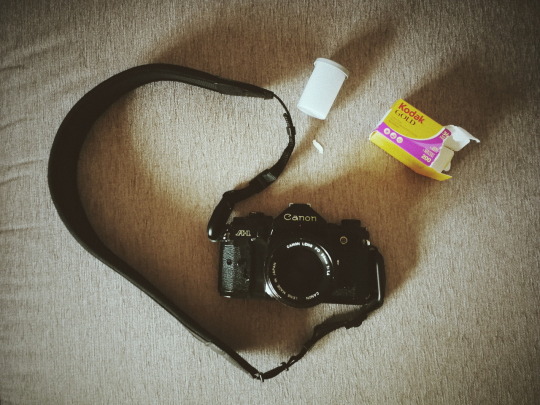
My trusted Canon A1 ready for summer vacations
But of course there are a large number of practical reasons for shooting digital, and at least for my needs and reality shooting film exclusively is just not an option. I shoot digital 95% of the time, but I always strive to make my photos look as “organic” and close to film as possible, because that’s the aesthetic I like the most.
For the purpose of writing this article I’ve questioned myself where does my fascination with film come from, and I guess it’s probably due to the fact that all of my childhood and teenage memories where shot on film. When I think about film I think about long summer vacations, family get-togethers and embarrassing haircuts - in other words, instant nostalgia! And that’s the kind of warm-fuzzy feelings that I want to associate with my photos, so basically ever since I got my first mirrorless camera back in 2015 that has always been my reference.
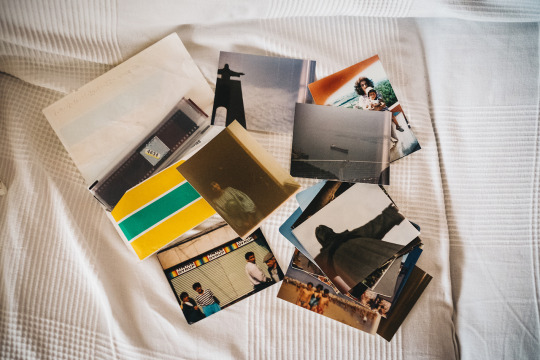
The first roll of film I ever shot when I was around 10, with a tiny plastic 110mm film camera
Over the course of these last 3 years trying to emulate film I’ve tried dozens of different presets for Lightroom, some of them really good, but quickly discovered that these will only get you halfway there. If you apply a film-preset to a perfect digital image file, in most cases you'll end up with a perfect digital image with some vintage tones, but there’s much more to film than that! There are a lot of “imperfections” that come from the limitations imposed by the gear used and the film itself, which have been eliminated in modern digital cameras and just can't be introduced in post-editing.
The best way I’ve found to mimic these imperfections is to actually impose some of those same limitations when shooting digital, so here’s a few tips on how to do that:
1. Use vintage lenses
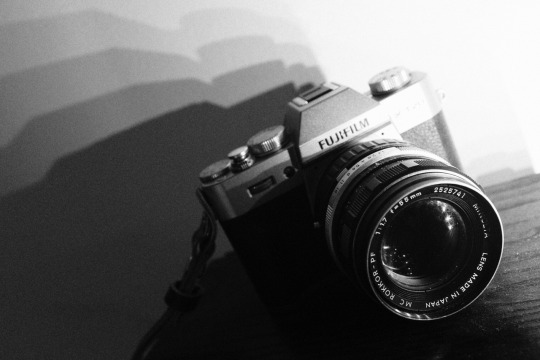
Modern lens are amazing pieces of technology. Most of them offer perfect corner to corner sharpness, great anti-flare coatings, amazing contrast, you name it. But if you're going for that 70s / 80s consumer film look, that's pretty much the opposite of what you need! Lenses back then where far from the perfection we know today, the consumer photography market was booming and there were a lot of different brands coming up with different designs, new materials, new focusing systems, etc. As a result, each lens had its very particular set of characteristics and quirks (sometimes design flaws, really) that got imprinted into every photo taken and ultimately defined its character. A perfect example of this are the Helios 44M lenses: these Russian copies of the Carl Zeiss Biotar became famous for a design flaw that resulted in a very unusual swirly bokeh. Earlier models displayed this effect very pronouncedly, but as they improved the design in subsequent versions that particular characteristic was lost, and that’s why the earlier models are the most sought after nowadays.
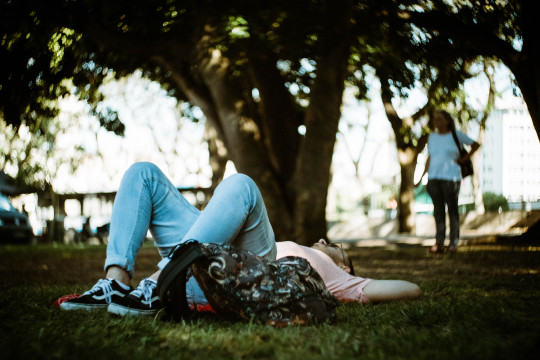

That classic Helios 44M-4 swirly bokeh
The good news is that these old manual lenses are (for the most part) dirt cheap and you can use them on mirrorless cameras with a simple plastic adapter, so you can get that specific look they were known for without any need for Instagram filters or post-processing magic! In my next article I'll go into more detail about these vintage lenses and how to use them.
2. Use manual focus
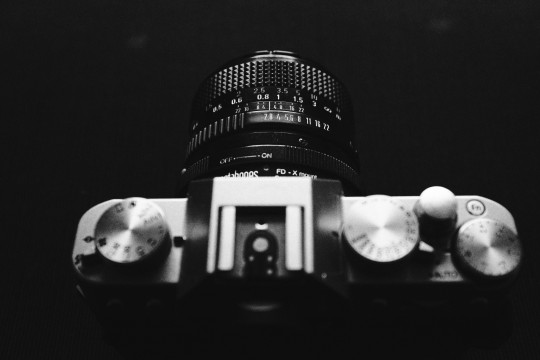
One of the biggest innovations in photography in the late 70s/early 80s was the invention of autofocus. Before that cameras were limited to manual focus, and even when the first AF systems were introduced to the consumer market they were rudimentary at best. Chances are that if you look at your film photos from that period, half of them will be slightly out of focus (or completely out of focus, depending on the competence of the photographer! ;)) But that’s not a bad thing at all, I feel that in most cases it only adds to the nostalgic feeling and can sometimes create an additional layer of mystery.

The missed focus on this one gives it a timeless feel
So if you want that classic film look, switch to manual focus on your modern digital camera or use an old manual lens. Don't be afraid to miss focus sometimes, this was something that took me quite a while to realize and “accept”, and I only did so thanks to shooting film. Some of my favorite photos shot on film are pretty out of focus!

Blurry? Definitely, but the fact that you can’t distinguish their faces makes this so much more universal
3. Use slow shutter speeds

Another limitation of film is the maximum ISO speed available, or Asa as it was called originally. Nowadays our digital cameras have incredibly high ISO sensitivities, but on film the maximum you get is 3200, though most consumer films are rated at 200 or 400 Asa. This means that to get a proper exposure on film you have to use much lower shutter speeds than on digital to get enough light, and as a result motion blur is highly likely. Personally, I love some blur, as it gives a sense of movement to an otherwise static medium. One of my favorite all time photographers, Anton Corbijn, shot many of the world’s most famous bands and musicians on film using slow-shutter speeds, to get some movement in the frame and that extra grit!


The subway rush - shot on a Huawei P10 smartphone
If you wanna try this out, I would advise to start with 1/30th of a second, look at the results and then adjust as necessary. If you’re shooting in bright sunlight this probably won’t work unless you use a neutral density, but again experimentation in the key.
A little extra tip: smartphones are actually great for this if you turn off the flash, as their small lens aperture and tiny sensor force slower shutter speeds to compensate.
4. Use High-ISOs for authentic film-like grain
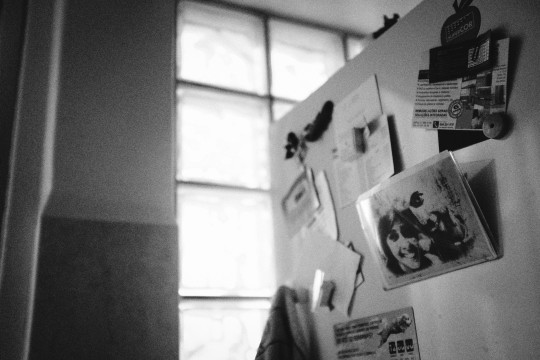
This tip is in direct contradiction with the previous one (unless you’re shooting in really low-light), so usually you’ll have to choose between one or the other. It is also a tip specific to the Fuji X series cameras, as I haven’t tested other brands in this particular aspect.
I’m a big fan of grainy photos, it’s one of my favorite things about film. But the technology in digital cameras these days is so good that in most scenarios you’ll get perfectly clean images straight out of the camera. Even though image-editing software has also evolved tremendously in the past few years and can deliver very believable grain simulations, I’ll be the first to admit that it’s not the same as the real deal and it also feels kinda like cheating to be adding fake grain. That’s where the Fuji X-trans sensors come in, in particular their latest iteration X-trans III.
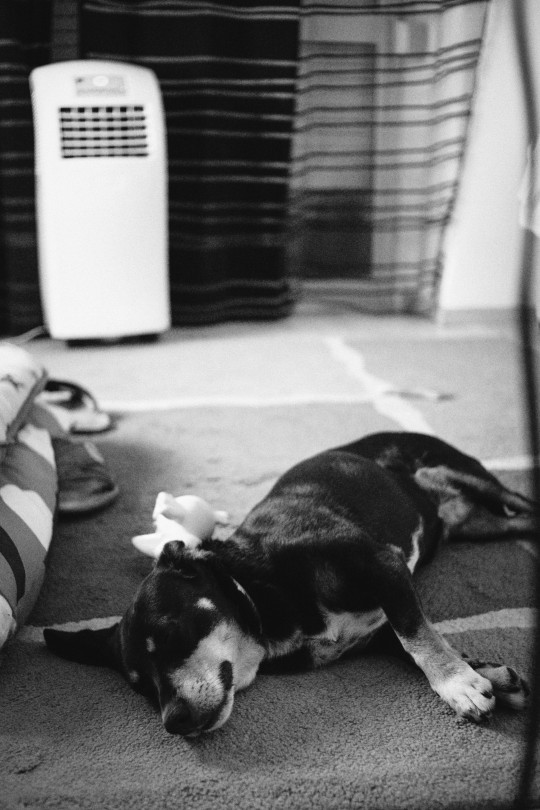
My furry friend shot at ISO 12800
The ACROS film simulation when used with high-ISOs of 6400 and above produces some digital noise that, to my eyes, is very very close to real Black and White film grain - and the best part is that you’re not adding anything fake in post-processing, it’s a real side-effect of ISO just like with real film! So most of the times when I want to shoot in Black & White I’ll use my own Acros custom setting at 12800 ISO and use the SOOC jpegs. This technique also works with color film simulations, but not so well in my opinion.
5. Post-process your photos accordingly
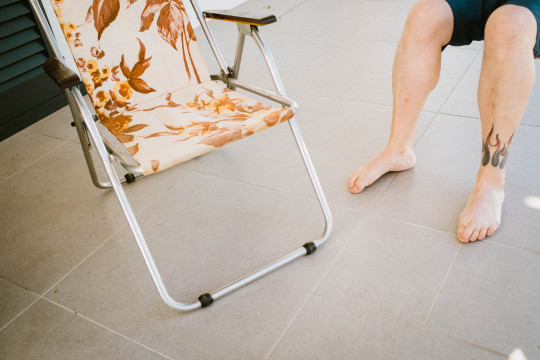
Different films have different characteristics, so it’s important to decide exactly what film look are you going for and learn a bit more about what defines it. Is it a low-contrast or a high-contrast film? saturated or muted? Fine grain or heavy grain? These things will help you understand what you can do in post-processing to get closer to that film look, and most of them are very simple to adjust. Where it gets a bit more complicated is getting the right tones to match the original film stock, but with some investigation and patience it can be done.

Going for that warm Kodak vibe
Of course if you want to save time you can just buy one of the many film presets out there! Like I said in the beginning of this article they will get you close to the original film tones, so if your base digital file already contains some “imperfections” introduced with the techniques above, it’s as close as you’ll get to the real thing. You can also use in-camera film simulation settings to mimic some film types, which I already covered in my previous article.
Can you tell which is which?
These are some of the techniques I’ve learned by trial and error mostly, I hope you’ll find them useful if the film look is your thing too. I can’t stress enough that the best thing you can do is to actually shoot film whenever possible, not only it will be great fun but it will surely improve your digital photography as well.
Let’s end this with a fun little game: can you tell which of the photos below are film and which are digital? No cheating looking in the exif data, I’ll post the results in a couple of days! ;)
1:

2:

3:

4:

5:

6:

7:

8:

9:

10:

#photography#film photography#film#digital photography#vintage lens#slow shutter#grain#grainisgood#post processing#fuji#fujifilm#fujifeed#fujilove#fujixseries#fujifilm x-t20#fujifilm x100f#canon a1#canon fd 35mm#helios 44m-4
12 notes
·
View notes
Text
Why is no one talking about this?
(Note: this is a long-winded rant(?) about a genuinely minuscule thing that really is just an excuse to nerd out, so if you’re into that, too, keep reading! Otherwise, you might not be that impressed. )
Yup, still on the My Hero Academia bender. Followers may have picked up my obsession over this purple-haired character named Shinsou in particular, but let me tell you that this character has less than some 20 pages in the manga and less than 20 minutes of screen time in the anime and is already more nuanced, complex, and emotionally compelling in that time than most of the characters in the protagonist’s immediate circle.
There are character analyses out there that do a great job of explaining all those points (this is one of the best I’ve seen and you should probably read that first and come back: http://manipulatorshinsou.tumblr.com/post/166609989279/the-appeal-of-shinsou-hitoshi-analyses), but I want to point out a tiny detail that I feel like almost no one has explicitly brought up that says something so enormous about his character arc that, though redundant at this point, is such a small but lovingly crafted detail that it really encapsulates one of my favorite things about this series - subtle emotional storytelling.
Now, there’s mild spoilers for all this, but you REALLY should go watch/read this series at some point anyway. However, I wanted to point something out that’s unique to the anime adaptation. Though some details often get left out in the adaptation process or are edited to fit film storyboarding rather than comics, film has a distinct advantage over manga in two areas - color and space.
Now, the entire point of Shinsou and Midoriya’s duel in the Tournament Arc was to draw multiple direct parallels to each character and highlight the major and really only significant difference between them - luck. In the end, both must fight an uphill battle above and beyond what would be expected of them to achieve their dream; but unlike Midoriya, Shinsou loses and his dreams are dashed. He’s no longer just disillusioned with the popularity games of hero society - he becomes discouraged and disheartened completely from having every last effort and every last plan easily pushed aside from someone more fortunate than him despite his efforts to appear confident and intimidating and to put his rivals off-balance.

Midoriya knows exactly the kind of struggle Shinsou has been through, and half the battle was to keep himself from trying to comfort Shinsou, not just because of All Might’s secret, but because they were rivals fighting for their own individual dreams, and attempting to help him would have resulted in Midoriya losing the match and the tournament. He also knew that after the fact there was nothing he could have said to Shinsou that would have given him comfort. Despite every amazing effort, he would once again be put down - the loser who just has to deal with the cruel reality of life.
Okay, nerd analysis time!
MHA is amazing at being emotionally compelling. They hit just the right line of performance, framing, and music to make you feel exactly what it wants you to. The example in particular I want to bring up is this scene (that legit put my husband -who is very much a “manly man”- in tears when he watched it).

At this point, Midoriya is told by the person he looks up to and admires more than literally anyone else in the world that regardless of his past inability to even come close to reaching his goals he still had the power to become a hero because of something beside and far beyond just having a powerful quirk.
And Midoriya is broken and in tears.
The cherry blossoms are a detail unique to the anime regarding this scene (Chapter 1) and really serve to add to the drama of it - particularly because of the saturation of color and the cultural significance of the Japanese sakura: the beauty and fleeting nature of youth, the coming of spring, and renewal. The Japanese consider the falling of the cherry blossoms to be a reminder that “it’s time to pay attention to what’s happening right now!”
Midoriya has finally experienced his own blossoming as a hero. Based on the scene in this episode and the direction the petals are falling insinuate that this feeling is all around him. His hero is standing over him and telling him that he can become just as great as he is. Everything at that moment has come together to recognize his dream.
Fast forward to Shinsou’s flashback at the tournament:

Absolutely the cherry blossoms are there, and it’s even clear in the manga that there are cherry blossoms outside the class window. However, what happens in this scene is that Shinsou recollects a point in his life that he considers to be the epitome of his struggle.
“Whoa, Shinsou! That’s a really cool quirk! Just don’t use it on us and make us your slaves, okay?”
“Heh, everybody says that...”
And the scene goes grey. This should have been his chance to break out and come closer to his dream, but that wasn’t the case. No color, no focus- just a blurred, painful memory to encapsulate the seemingly inescapable feeling of defeat as he lays on the ground, out of bounds, so close but yet so far once again...
And then-
~~~~~~
“You’re amazing, Shinsou!”
“You’re the shining star of General Studies!”
“His quirk is so powerful and can be so useful in capturing villains!”
“What a waste that he’s stuck in General Studies!”
“I wish I had a quirk like that!”

No “what a scary quirk” or “I hope he doesn’t use it for his own purposes”! Just:
“Look at what an amazing hero he could be!”

Did you see it?
There isn’t a cherry tree for miles around this arena. Everything for so long has been against him from the start. The fire inside him has all but been snuffed out yet again. This should be like every other disappointment he’s had to endure, and yet somehow it isn’t - against every odd.
He may have lost. He may have fallen short, but his real goal has been realized. He’s been seen. It’s time to pay attention to what’s happening right now. Shinsou has blossomed.
It’s not as flashy or spectacular as Midoriya’s, but it’s just as significant. In fact, it’s exactly the same, regardless of how big it shows on the outside - Midoriya and Shinsou are the same, and they’ve both made it.
Again, this detail of the single petal falling isn’t in the manga (Chapter 34), but it was even more emotionally impactful to me than Midoriya’s awakening because I immediately saw the parallel. I feel that many did, too; but the choice to have the one fall into frame hit me where it counted. It almost wasn’t there, but it was!
I’m done rambling at this point, but really if you haven’t at least checked out this series yet, I highly encourage you to - even if you don’t like normally like anime! Most of the elements that tend to put me off of a lot of popular series are minimal or non-existent, and though it still uses major tropes in the shonen genre it has a tendency to go above and beyond philosophically, intellectually, and emotionally than it has to. It’s not a good anime. It’s a well-written and impactful story!
#bnha#mha#bnha shinsou#hitoshi shinsou#hitoshi shinso#my hero academia#boku no hero academia#deku midoriya#midoriya izuku
2K notes
·
View notes
Text
Shooting with a 21-Year-Old Camera: The Fujifilm S1 Pro
I find it incredibly fun to use older, especially unique, digital cameras both as a challenge and for sheer enjoyment.
I think part of it is psychological. With archaic cameras sporting outdated technology we anticipate subpar results, and so we focus more on what we can control: composition, lighting (when applicable), exposure, and so on — the things we should always be focusing on.
Conversely, when we have a Hasselblad in our hands, we may let go a bit in the unconscious belief that the camera can make up the difference for our lack of talent or effort. Of course, we all know it can’t.
I won’t get into the boring history of why I own a lot of early to mid-2000s digital cameras, but at some point, I found myself the owner of a Fujifilm Finepix S1 Pro — the first in a five-model line of Fujifilm DSLRs that housed some incredibly unique sensor technology that it dubbed “SuperCCD.”
Apologies for the subpar product photos. I didn’t have access to my full setup.
In the S1 Pro, the photodiodes of the 3.1-megapixel SuperCCD sensor took the form of a honeycomb tessellation, oriented in a zig-zag array rather than a simple vertical/horizontal mosaic. Because of this, the distance between cells is smaller, making for about 40% more (square root of 2 = 1.41) sensor cell rows horizontally and vertically than a regular Bayer sensor.
The camera then uses an interpolation algorithm that supposedly results in a resolution equivalent to a 6.2 megapixel Bayer sensor. The 45-degree orientation also allows for improved capture of horizontal and vertical detail. This is good because most of the world, thanks to gravity, exists in horizontal and vertical planes — however, this happens at the expense of diagonal resolution, which is where traditional sensor layouts excel.
The honeycomb design of the SuperCCD sensors.
Released in January 2000, the Fujifilm S1 Pro is based on the Nikon N60 (aka F60) film camera body (with modifications by Fuji). It logically sports a Nikon F mount and can use AI, AI-S, AI-P, AF, AF-D, or G type lens — however, only AF and AF-D lenses will autofocus. AI and AI-S lenses can only be used in manual exposure mode as there is no meter coupling.
Most of these photos were shot with either the Nikon AF-D 24-120/3.5-5.6 or Nikon AF-D 50/1.8. While the 24-120 is not a quality optic, it’s a more than sufficient match for this sensor, especially stopped down a bit — and you can stop down to your heart’s content without hitting diffraction on this camera.
I had initially gone out shooting with some superior G-type lenses, however, accurate manual focusing is impossible for me through the straw-like OVF (wearing glasses doesn’t help either) and the focus confirmation dot is totally unreliable. Strangely, I had more issues manually focusing on distant objects stopped down than closer ones wide open — the photo above was manually focused with the Sigma Art 35mm wide open at f/1.4, yet the below photo (slightly out of focus) was at 24mm and f/8 with the Nikon 24-120mm f/4G VR.
Shutter speeds top out at 1/2000th. There are several metering modes (3D 6-zone, 6-zone, center-weight), a pop-up flash and hot-shoe (Nikon TTL compatible), and ISO options of 320, 400, 800, and 1600. There is no auto ISO function, and you have to menu dive each time you want to adjust it.
File choices are JPEG or TIFF only — no RAW, unfortunately — recorded to either CompactFlash or SmartMedia. The camera certainly did not accept my 64 or 128GB cards, but I was able to dig up an old 1GB card that can hold a whopping 56 TIFF files in the highest quality mode available (“Hi RGB TIFF”).
This is easily the slowest camera I have ever used. The menu is the antithesis of intuitive; it’s mostly just a collection of symbols and abbreviations and my hat is off to you if you can guess their meaning without reading the manual.
Forget chimping. Just murder that idea and bury it. It takes a solid 31 seconds (yes, I timed it) for an image to populate the screen. Once it does, just about the only thing you can confirm is that a photo was indeed taken, though a histogram is available for more accurate analysis. JPEGs, however, are significantly faster to review.
In a way, if you choose TIFF over JPEG, using the camera is akin to shooting a bulked-up Nikon N60 loaded with a roll and a half of film — no image review, roughly 55 maximum shots, and no quick adjustment of the ISO.
The S1 Pro allows you to choose between either 3.1MP or 6.2MP output. To produce a traditional image file — which exists in rows and columns — the camera must interpolate by using adjacent photosites to generate data between existing pixels. After all, the recorded file can’t exist in the same zig-zag honeycomb pattern as the sensor. After each line is read out and the missing data is filled, you end up with twice the spatial resolution (6.2MP).
Compared to the Nikon D40, which uses a 6.1-megapixel Bayer sensor, the S1 Pro doesn’t quite reach the same level of pixel acuity. However, side by side with the 4.1 megapixel Nikon D2Hs, there isn’t much in it between the two. So, I think the real Bayer-equivalent resolution sits somewhere in the middle of 3.1 and 6.2MP — around 4-4.5 megapixels. As it would happen, this is exactly in line with the roughly 40% increase in sensor cell rows (3.1 * 1.41 = 4.37). It also depends on the scene — some benefit from the unusual sensor design much more than others.
CCD sensors are not forgiving of sloppy exposure. Pushing or pulling can quickly result in blotchy chroma noise, severe color shifts, and compromised roll-off from the quartertones into the highlights. It is not unlike slide film in this way.
The colors are phenomenally accurate and neutral out of the camera. “ORG” tone and color produce a lovely, neutral file that’s perfect for editing, and “STD” (standard) tone and color make for a pleasingly usable straight-out-of-camera file. Even with color set to “HIGH” and tone set to “HARD,” the images aren’t bombastically oversaturated and Disneyland like we often see with the “Vivid” setting in modern cameras. In fact, High Color/Hard Tone photos exhibit only a very modest bump in saturation and contrast compared to Standard Color/Tone. One thing is perfectly clear: Fujifilm was producing cameras with beautiful color output long before X-Trans.
All the images here were shot at ISO 320, 800, or 1600. ISO 400 is completely pointless given that it’s a mere quarter stop gain over base. It would be easier to just dial in a third of a stop of exposure compensation rather than clicking through the menu. I really wish there was a lower base ISO of 160, as well as intermediate options like 640 and 1280.
The camera’s high native sensitivity — combined with early CCD architecture — means that there is a noticeable level of noise even at base ISO. Thankfully, the noise is quite pleasing and mostly luminance up through ISO 800 — even 1600 has very minimal chroma noise straight out of the camera. Anecdotally, I’ve found this to be a running theme with CCD sensors — considerable noise even at base ISO, but the noise presents very favorably through most, if not all, of the sensitivity range depending on the camera. It also makes for astonishingly appealing black and white photos, especially given the finely grained texture from what is largely high-frequency noise. “Film-like” would be an apt descriptor for the results.
The considerable noise in this image is the result of bringing up an underexposed photo in post. Black and white helps cover the color shifts and chroma noise.
If you nail exposure in camera, ISO 1600 will produce remarkably great results with an unexpectedly low amount of noise for a sensor of this type and age — there isn’t much to speak of in terms of offensive noise and photos are completely usable without any noise reduction. However, at this point, you’ve lost a good bit of dynamic range and if you try to push the image in any way, blocked up patches of low-frequency chroma noise and banding immediately rear their head. There is essentially zero room for pushing the files at all if shot at ISO 800 or higher.
Quite impressively, there is almost nothing in terms of color shift throughout the entire sensitivity range — what is accurate or pleasing at base ISO will be accurate or pleasing at 1600. Again, this is something I have noticed on more than one occasion with CCD cameras — the Pentax 645D behaves almost identically throughout its ISO range.
ISO 1600, SOOC “Standard” color and tone, auto WB. Noise reduction and sharpening zeroed out in ACR. No adjustments aside from downsizing.
While restrictive by modern standards, a highly usable ISO 1600 in an APS-C camera in the year 2000 was exceptionally good. Fujifilm claimed the SuperCCD cameras to have superior sensitivity performance — the honeycomb photosites allow for more pixels to be packed within a given area and their shape more closely mirrors the circular microlenses that sit above them. I think Fuji’s assertation bears out in practice.
I would estimate roughly 7.5-8 stops of usable dynamic range, which is up against what I presume is an 8-bit ADC (analog to digital converter). Given this, along with the unforgiving nature of CCD sensors and processing latitude further limited by the lack of RAW, you need to be very deliberate with your exposure choices. Even in a scene of moderate contrast, you will almost certainly have either crushed blacks or clipped highlights.
However, like most CCD cameras, you do start to lose dynamic range quickly once you boost the ISO by a couple of stops. There also isn’t much in the shadows — modern cameras (CMOS) tend to have a lot of their dynamic range bunched up in the shadows, allowing for some truly incredible detail recovery. CCD sensors do not work the same way, and even with a full-blown RAW file, I doubt you’d find much usable information at that end of the histogram. You can mitigate this somewhat via ETTR (“expose to the right”), but with what is already a suboptimal amount of dynamic range, you’ll only have a small amount of latitude for ETTR, if any.
Oops, highway patrol got me. High contrast scenes like this are difficult – the whites are just on the cusp of clipping, but the blacks are gone in numerous areas.
While the camera’s light meter, particularly the 3D 6-zone multipattern meter, is exceptionally adept at balancing exposure in difficult scenes, the auto white balance is a duality: it’s either one of the most accurate I have ever seen or it’s the worst. Almost all the photos I took required zero tint adjustment and usually only +1 to +4 temperature adjustment. However, on three occasions the images were off by so much I’m still baffled as to exactly why.
The most egregious were photos taken about two hours before sunset in the shade — they were rendered extremely blue and about half a stop underexposed. The white balance went so far off the map that most of a plain white T-shirt measured blue values from 240 on up to completely clipped! I assume the culprit for this error is a combination of the camera’s CCD light meter design and spectral response — the infrared filter may be causing issues in certain situations too. IR filters can strongly affect the blue channel and it’s possible there was a bit of Rayleigh scattering at work.
The major issue is that without a RAW file, your options are extremely limited — those botched files required +76 temperature to correct. Such a massive shift in an 8-bit TIFF file results in horrendous noise — especially bad because the blue channel is always the noisiest — and extreme spectral shifts across the entire image. Strangely, a separate shot of a red step ladder taken five feet away at the same time required only -3 tint and zero temperature adjustment.
Using the S1 Pro reminds me of shooting with the original 18-megapixel Leica M9 and Leica M Monochrom cameras — both with Kodak CCD designs. Neither those cameras nor the S1 Pro has any tolerance for “underexpose to protect the highlights” or similar approaches in the same way that CMOS sensors allow — not unlike how slide film doesn’t take kindly to push processing. People who worry about how a camera handles being pushed five stops will need to adjust — it’ll help them in the long run so they can finally learn to stop underexposing so much.
Ultimately, while the files from the S1 Pro don’t contain anywhere near the latitude of even modern JPEGs, let alone the power of RAW, my biggest takeaway while using this camera was how much I adore and value transparency as a starting point out of the camera. In a way, the naturality of colors and tones from this camera makes it even more aggravating that the files can’t stand up to much manipulation — I would absolutely LOVE results like this out of my Nikon Z7, and every other camera I have for that matter.
My father assisting in the repair of a Pentax 6×7. In scenes like this, you just have to expose for your subject and let the extreme ends clip.
What I would love to see is a universal “Natural Color Solution” (to steal a term from Hasselblad) adopted by all manufacturers and implemented in their cameras as an option. If you want that “Natural Color” RAW file, you can have it. If you want the look that you’ve come to love from your manufacturer, you can pick that too. Aside from Hasselblad, I’m not sure what would be the risk for manufacturers to do this — other than that it would take some effort and time.
I would not call the Fujifilm S1 Pro a fun or pleasant camera to use at all. To be honest, I probably immediately deleted 99% of the photos I took while doing this review. And even among the ones you see here, there are more than a few that I am not happy with. Normally, I would not settle for posting simply passable images, but in this case, I think even the lesser photos here do have value by showing both the warts and the ornaments.
Have no doubt, this is a challenging camera to use. I’m sure my images would greatly improve with continued use, but how much I am not sure — I feel like you hit the ceiling quicker than you might imagine.
Perhaps I can follow this up with a retrospective review of 2005’s Fujifilm S3 Pro, which sports a new SuperCCD SR sensor with two photodiodes per photosite — one of normal sensitivity and a smaller one of lower sensitivity. Both are combined to produce enhanced dynamic range (and it works very, very well). The general principle behind such a design comes from the structure of the crystal coating in silver halide film. The S3 also has a 14-bit ADC and produces 14-bit RAW files! That’s just a few of the improvements, but I’ll tell you this much: the SuperCCD SR sensor does NOT disappoint.
from PetaPixel https://ift.tt/3Ambu6I
0 notes
Text
The Wicker King Book Review
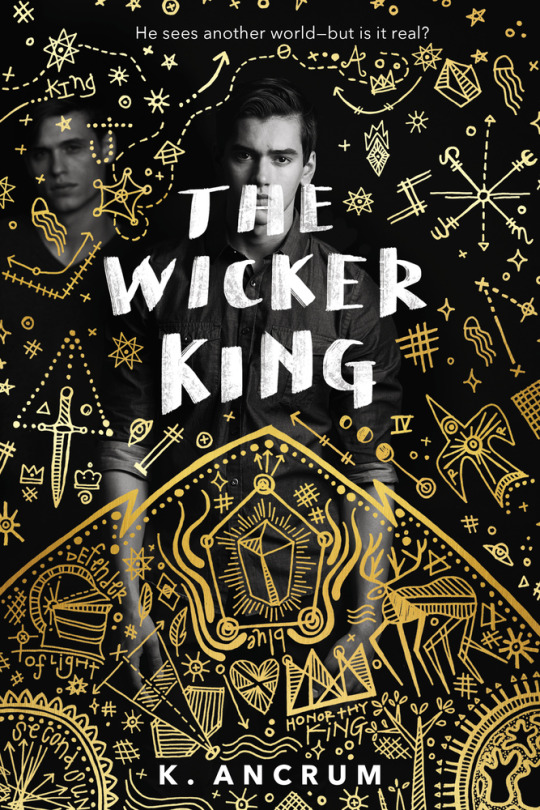
The Wicker King Book Review by K. Ancrum
Wowie, wowie, this book was a trip. Unfortunately I don’t mean that in the wow-what-a-fantastic-new-Miyazaki-movie-way because let’s be real, all of Hayao Miyazaki’s movies are a mind reel and anyone who actually understood all the intricacies of Spirited Away the first time they watched it is a bloody liar. That being said, The Wicker King is a fairly new publish by unknown author K. Ancrum that brings you the story of two very sad young men and their battle with negligence and mental health amongst a slew of other issues.
This was one of those books where nothing has been written about it and is largely ignored on every major social media platform. It’s hard to say why some books such as The Gentlemen’s Guide to Vice and Virtue seem like they have daily advertisements on Tumblr and Goodreads, while other books like this one are as noticeable as my Harry Potter fan fiction from 10 years ago. That being none at all.
I happened to stumble across this black little book on the shelves at Barnes & Noble over the holiday highdays on complete accident. Every few months I scour the shelves for anything and everything that captures my limited attention when it comes to young adult literature and this little beauty popped up for two reasons: the color of the pages and the synopsized fable of two tragically intertwined best friends.
Male best friends. Immediate zinger right there.
Unfortunately, good LGBTQ+ young adult literature is still highly limited and those that do exist are saturated with stereotypes and one dimensional characters flat enough to slip under a doorway. So, when a story so much as whispers about two best friends of the same gender needing each other and strongly hinting at not-so platonic feelings I am going to pick it up and I am going to read it.
Enough said.
However, that does not always mean I enjoy them (ie. The Love Interest by Cale Dietrich was an absolute train wreck). In the case of The Wicker King, I enjoyed some aspects of the story but found myself more disturbed at the end then hopeful. Let’s get down to the nitty gritty then.
Step one: the characters. It took me almost 20 pages to be able to differentiate between Jack and August, our two main protagonists. Although they're both described on the inside jacket as a pyromaniac and a golden sports boy respectively, it was difficult to figure out which one was which. And although Ancrum made it quite clear that the two boys are in two completely different social circles and don’t interact at school because it would confuse people, she yet starts doing that exact same thing almost immediately with no consequences or thoughts outside of a few petty comments.
As for the characters themselves I liked them. Jack seemed a little off kilter for reasons I won’t give out in fear of spoilers, but I did end up liking August despite everything. Ancrum also portrays some interesting female characters who seem tough and mean. Mean female characters are always fascinating to me (Blair Waldorf for the win anyone?)
Step two: the writing itself was staged and written chronically but in a way that delivered almost as snapshots. Ancrum didn’t so much have chapters as she did little sneak peeks into Jack and August’s lives. Each “chapter” was maybe a page to three pages before it would end. It was an interesting way to read in that it felt like you weren’t getting the whole picture but instead little peepholes that kept you guessing.
If this sounds like a turn off, don’t let it be. The way in which the scenes played out was smooth and cohesive, it was actually quite refreshing to read something that wasn’t an uber long chapter. It was easy to be sucked in and say, “okay, just one more, one more.” Just like me when I’m eating Cheetos.
Step three: graphics and coloring. In this aspect The Wicker King gets a 10/10. Ancrum was incredibly creative in a way that I found deeply impressive. The pages start off cream with black text as is pedantic for almost all novels. However, her pages slowly start to change from white with black text to completely black pages with white text. The transition follows the seamless progression of the plot: as the story gets darker so do the pages. The idea is so simple, and yet I’ve never seen it done before. Kudos to you Ms. Ancrum.
There is also something strangely satisfying about seeing the pages darken in front of your eyes as the main characters start to hallucinate more and lead to events like drowning and catching fire. In addition, Ancrum also includes little snippets of digital media that are scattered across the pages systematically: a brain scan here, a Police report there, a photograph, or a torn page of a notebook. I liked how they added to the story and filled in some holes left out by the snapshot writing process.
So you might be wondering, wow, this book sounds super creative and impressive, what’s wrong with it? That leads me to step four.
Step four: it was sad. Not in a Fault in Our Stars way sad, but sad in a way that leaves you cringing and looking for comfort food. The Wicker King is disturbing in its realistic portrayal of child abuse, neglected mental health, poverty, and just full blown ignorance. It’s frustrating to know that if Person A had just stepped in here or if Person B had actually paid attention, Jack and August could have had much better, healthier, happier lives. Alas, that doesn’t happen.
Sometimes I like reading about sad things in real life-like serial killer cases or child abduction or listening to any news station honestly. However, those instances are few and far between. Personally, reading is an escape from life that can sometimes be too harsh and unforgiving and so when I have to escape from my escape, it’s always a despairing occurrence. I realize that this is not the case for everyone. If you like to read about forlorn and melancholic characters, this is definitely a novel that might intrigue you. K. Ancrum personally wrote characters like Jack and August to relate to other kids who have lived the same dismal existence. If the rest of you are like me, you might be better off skipping over this one.
Recommendation: Unless you feast on the woebegone, love being inconsolable, or are studying pictorial representation and graphics in literature, The Wicker King is best left as an unknown book on the shelves that you always notice but have no interest in picking up unless you feel like sobbing.
Score: 6.5/10
#the wicker king#k ancrum#book review#book blog#teen books#ya fiction#books recommendations#lgbtq fiction
52 notes
·
View notes
Text
5 Laws Anyone Working in thietkevanphong Should Know
The common Workplace employee spends greater than 1700 hrs during the Business, each year. Making these several hours depend is vital to any business' accomplishment, as well as the Performing natural environment can have an enormous impact on employee safety, ease and comfort and as a consequence, morale.
™

Deciding on the ideal topic for the Business space can look like a simple task, although the selections you make about furnishings and colours can have an affect on how you and your teamwork. There are many of possibilities out there, from special, design-concentrated chairs, to ergonomic masterpieces and of course, colour choices for your Place of work are Nearly limitless.
So how Did you know what is correct for your personal staff and space?
Deciding on the colour palette
Bright colours in an Business atmosphere are normally considered to be motivational and might market positivity and inspire creativeness. Significantly less saturated tones for example pastels can develop a much more calm, calming ecosystem so can motivate productivity and focus. Depending on the sector and type of work your staff is endeavor, colors and capabilities can affect the main focus in your Business office.
Invest in Business furnishings
It's essential to pick the right furnishings on your group. With a range of potential choices, together with seated or standing desks, you have to be capable of finding the ideal home furniture Resolution on your Room.
Herman Miller would be the brains at the rear of a group of nicely-revered ergonomic chairs, which are ideal for Office environment personnel who invest nearly all their working day seated at their desks. A further significant contender for an all-day sitter could be the Humanscale Freedom Chair, which is another great ergonomic possibility and has a range of colour choices, rendering it marginally more customisable based on your Business topic.
Probably the greatest improvements to come from Office environment home furniture in recent years is definitely the sit-stand desk. This permits buyers to simply changeover from the seated placement to some standing posture. There's a serious level of blogging on the internet with regards to the sit-stand desks as well as likely Added benefits that may be received from varying your Functioning position. Elite Office Home furnishings provides A variety of sit-stand desks that might accommodate anyone Doing work a more flexible Workplace setting.
Away from the desk chair, It can be well worth considering any added seating places that would be utilised as part of your Business Place. If you're Doing the job in a very creative field, using time away from the 'norm' of the desk can help Inventive juices move. Choice seating, together with Conditioning balls, the Aeris Swopper and Orangebox's armchair array are perfect for casual seating That may just help you get the ideal Thoughts out of your workforce.
If the Business office could do with a rethink, take a Go searching our Internet site at our in depth variety of Business office furnishings and develop the best workspace for the challenging-Operating workforce. Office environment Home furniture Scene is suppliers of the best luxurious furniture corporations on earth, stocking models for example Herman Miller, Orangepod and the entire world-class brand, Humanscale. If you're soon after products that could past a lifetime, without having fear of producing faults or technical mechanisms, you'll be able to make sure to obtain them on our web-site.
All of us know that In case the ecosystem close to us is neat and clear, it encourages superior overall health and jovial mood. Workplace clearance is just not one of them on a regular basis discussed topics but it has a terrific impact on our well being as well as productivity. Living and working in the hygienic ecosystem not just retain both you and your employees healthful but results in greater productivity also. So if you wish to Enhance the Over-all quality of life all around you then you most take into consideration Workplace Clearance in London significantly. But irony with most of us is that we maintain our self way too occupied with everyday matters and continue disregarding Business office waste disposal challenges. That eventually leads to the buildup of garbage after a while around the place of work and this phenomenon is harmful and unpleasant for everyone all-around.
That is why Specialist Workplace clearance and garbage elimination organizations Enjoy a major role in retaining your place of work nutritious and enjoyable. Such solutions are simple to use and can certainly make your workplace clear and hygienic without the need of Placing any burden in your shoulders. Experienced Workplace clearance companies make arrangements to get rid of your junk in an inconvenience-no cost fashion. If you are preparing Business Clearance then it can be suggested to choose Skilled assistance as these gurus have an intensive understanding of how to manage your situation with none disturbances.
Place of work rubbish removing can be quite a demanding exercise due to the rules set by the government concerning Business squander disposal. Big Place of work furnishings and also other products have to be disposed of diligently usually it may result in severe accidents. It is important to take the right method even though clearing large products and none besides an experienced can provide the answer. Yet another significant Element of clearing rubbish is definitely the disposal of Digital items that need to be completed based on the set laws. As disposal guidelines continue shifting occasionally, it becomes important to seek the services of gurus mainly because these elimination companies preserve themselves up-to-date with the most up-to-date laws and pointers. So if you are searhing for a solution to your Business office rubbish Then you certainly have quite a few alternatives regarding removal corporations and it is best recommended to pick by far the most expert support company to cater to Office Clearance in London needs. Skilled provider vendors have specialists which have been effective at sorting your squander and even more send out it for reuse, incineration, recycling, and so on. as per necessities and principles.
Workplace clearance and rubbish removal is usually a nerve-racking and overwhelming task for Many of us but when you finally employ the service of a highly skilled Expert the method receives done speedily with out putting any burden on you or your workers. You'll be able to continue your day to noithatvanphong.com day program whilst clearance treatment is in the procedure as Experienced ensures there is not any disturbance to you all through their functions. Given that the specialists take care of anything which include selection, isolation, disposal, etcetera. without supplying you with any anxiety. Business Clearance might be a annoying process but when you experienced employed specialists this can get completed with no hassles. Waste disposal businesses are totally able to managing virtually any squander successfully as well as a cherry to the cake is you are able to continue on together with your official schedule.
0 notes
Text
How to Use Instagram Filters in Paid Social Media Campaigns
One billion – that’s how many people use Instagram each month.
With such a huge, highly engaged audience, you can bet the competition between brands is tough. This is why small details can make all the difference, and Instagram filters could play a part in making your social media campaigns more successful.
What are Instagram Filters?
Everywhere you look, marketing advice says you need high-quality images to succeed on platforms like Instagram. But what if you’re not a professional photographer?
This is where Instagram filters can be a game-changer for your marketing and particularly your paid social media campaigns—they can make your images look as sleek as if they’d been professionally shot.
Here’s an example of an unfiltered image vs. its filtered twin:
Not only do Instagram filters make things look cleaner, but they also allow you to edit your image with one click. Where most editors make you alter contrast, saturation, and so forth individually, Instagram lets you pick a pre-set filter that suits your image—though you can tweak them if you’d like.
While these filters have been around since 2011, they’ve taken off in recent years. With the added capabilities of augmented reality (AR) technology—which adds imaginary images to those of the real world—they can significantly impact your social media campaigns.
Why Should You Use Instagram Filters in Your Paid Posts?
Social media platforms are competitive, and standing out from the crowd isn’t easy. If you’re going to get the best cost per click with your paid social media campaigns, then your brand needs to grab attention and drive engagement.
When you run an Instagram ad, you don’t have much real estate to work with, so you’ve got to find ways to draw your audience in with the limited space you have.
If you can combine innovative use of filters with creative images and excellent text, then you could achieve exceptional results— as Opel did with their “Opel Adam” campaign. In just two weeks, the campaign achieved a 2.5x increase in registrations and significantly lowered Opel’s cost per registration.
It’s possible to achieve the same results for your business, but you’ve got to make the most of the tools available to you.
If only 18% of Instagram posts use a filter, this means you’ve got an opportunity to make your content stand out over the other 82%. Research shows that AR filters have an average dwell time of 75 seconds, which is four times that of even video content—so using it can make a huge difference.
Social media platforms crave engagement, and if your advertisements give them that, you may find you reach more people for less—and Instagram filters are one of the best tools to help you achieve this.
How to Use Instagram Filters for Your Paid Campaigns
Turning your posts into paid campaigns through the Instagram app couldn’t be easier. All you need is a business or creator account, and then you can get set up with your paid ads.
Click the profile icon in the bottom right-hand corner.
Select promotions.
Choose a post to promote. Instagram will prompt you to use your top post, but you can select any of your previous posts to promote.
Select where to send people— your profile, website, or direct messages.
Define your audience. The easiest option is to choose “automatic,” which targets people similar to your followers, but you can create your own.
Choose your budget, setting your daily cost and how long you want the campaign to run for.
Review and publish.
To create a promotion through the app, you need to have already created your post or story. Luckily, Instagram makes it exceedingly easy to snap an image on the go, add a great filter, and promote it within seconds.
Tips for Picking the Right Instagram Filter for Your Campaign
The right Instagram filter might be a quick way to give your images the professional touch, but the wrong filter can have the opposite effect. When you’re choosing your filter, keep these three points in mind:
Your images reflect your brand
Consistency works well on social media
Don’t go filter crazy
Your images help define your brand, so the filters you choose matter. Your filters should reflect the mood of the product or service you’re promoting, and you need to stay consistent with this.
A great example of this is JetBlue’s Instagram account. You can easily spot how consistency has allowed them to develop their own simple yet effective style by using similar image styles, colors, and more.
While the right filter can make things look amazing, “over filtering” can have the opposite effect. You don’t want to alter things so much that they look surreal. Instagram filters are optimized to please, so it’s often worth sticking to the tried and tested rather than over-editing.
If you’re looking for inspiration, Canva studied the most popular filters, and Clarendon, Gingham, and Juno came out on top.
Instagram Filters for Posts
Adding filters to your Instagram posts couldn’t be easier. In five simple steps, you can post amazing images that grab your audience’s attention.
Click the + button at the center of your home screen.
Select the image you want to use from your library, or select “photo” or “video” to create a new one. Click next.
Choose your filter from the list at the bottom of the screen. Remember, you can add more by clicking manage at the end of the reel.
Add your caption, tag people in your posts, post your location, and choose other social platforms you would like to post to.
Hit share.
Instagram Filters for Stories
Instagram stories allow you to post photos and videos that vanish after 24 hours. One-third of the most viewed Instagram stories are created by businesses, so they are an excellent way to make your posts go further.
The process of posting stories with filters is just as simple as with posts, but you’ll notice a lot more options when it comes to AR filters.
For a live video or image:
Select your profile icon.
Hit the + button in the top left-hand corner.
Select “story” from the pop-up menu.
Use your camera to take live video or images, or select an existing one from your library by clicking on the image in the bottom left-hand corner.
Choose between your front-facing and rear-facing camera if you’re taking a live image.
Select your filter from the reel at the bottom.
Tap the center button to take a picture or hold the button to take a video.
Use the editing buttons in the top right-hand corner to add extra filters, overlay text, or download to your library.
Hit “send to” and select where to share your story.
Bonus Instagram Filter Tip
If you’re scrolling through Instagram and see a filter you like, you can save it to use on your own stories.
Go to the profile of the person with the filter you like.
Click the smiley face emoji to see all their filters.
You can save it by clicking the down arrow or try it on.
When you’re trying on the filter, click the drop-down menu.
From here, you can save the effect or send it immediately as a story.
The next time you send a story, the filter will be ready for you to use.
Instagram Filters for Faces
When you created your first story pin, you likely noticed there are a lot of things you can do to your face with AR.
AR allows you to add computer-generated effects over the live image you see on your camera. For example, if you want to see what you look like wearing sunglasses, there’s an AR filter for that. The sunglasses appear on your face and follow you as you move.
There are endless Instagram filters with AR, which gives you more options to engage your audience. However, as with any Instagram filters, it’s essential to find the ones that suit your brand.
Some companies have had great success with AR filters on Instagram, such as this one by Ray-ban. But if you’re going to use these filters, then you’ve got to make sure you stay on-brand.
To create a story with AR filters, simply follow these steps:
Select your profile icon.
Hit the + button in the top left-hand corner.
Select “story” from the pop-up menu.
Choose between front- and rear-facing camera.
Slide between the filters at the bottom and watch as your face is brought to life with AR.
For more effects, slide to the end of the reel and select “browse effects.”
Choose a filter.
Click the middle button to take a photo, hold to take a video.
Click send and then select where to share.
Other Instagram Features to Help Your Paid Campaign
One of the reasons Instagram is so popular with advertisers is because it gives you lots of tools to give your paid campaign extra oomph. The beautiful thing about it is it’s so easy for anyone to add filters, gifs, text, and music to their images.
While a recent study found that images without text overlay generally perform better than those with text, marketing is all about finding the message that engages your audience, so it’s worth experimenting to find the formula that works for you.
These Instagram features give you added options when it comes to reaching and engaging your target audience.
Adding Gifs
Gifs provide a great middle-ground between static images and video. They were talked about as a big marketing trend, and while AR has taken over somewhat, they’re still a handy tool for your paid Instagram campaigns.
A gif is a quick and easy way to add something extra to your story, and once again, Instagram makes it exceptionally easy to do:
Select your profile icon.
Hit the + button in the top left-hand corner.
Select “story” from the pop-up menu.
Choose between front and rear-facing cameras or open your library via the icon in the bottom left-hand corner.
Take a picture, or choose an image from your library.
Choose the square smiley face at the top of the screen.
Select gifs, or use the search bar to find a specific gif.
Make your gif bigger or smaller by pinching in or out with two fingers and drag it into position.
Select “send” to and choose who you want to see your story.
Adding Text
Instagram might be a very visual platform, but that doesn’t mean there isn’t use for text. The right use of text can help give your posts and stories context, grabbing people’s attention and linking the image to your brand.
Text is a vital part of Instagram because this is where you make use of one of the most important features: hashtags.
Hashtags not only help people find your posts, but they also boost engagement and allow you to zero in on what’s popular in your industry. The statistics show that Instagram posts with even just one hashtag can see an increase in engagement of 12.6%. So with only a little extra text, you can give your campaigns a better chance of success.
You can also use text overlay on your stories. You’re in control of your text’s font, color, and look, which means you have another way of giving your images a professional look.
To add text overlay to your stories, simply:
Select your profile icon.
Hit the + button in the top left-hand corner.
Select “story” from the pop-up menu.
Select your image or video.
Click the “Aa” in the top right-hand corner.
Type your text.
Choose your font, color, and effects, using the tools at the top of the screen.
Hit “done.”
Select “send to” and choose your audience.
Adding Music
Music has always played an important part in advertising. Music helps make advertisements more memorable, evokes emotion, builds the story, and accentuates the brand, so it can be an essential tool.
While some people will use Instagram with the sound off, Instagram makes it so easy to add features such as music that you don’t lose anything by using them.
Again, make sure whatever you choose fits your brand and is going to engage your audience.
Here’s how you can add music to your Instagram stories:
Select your profile icon.
Hit the + button in the top left-hand corner.
Select “story” from the pop-up menu.
Choose between front and rear-facing cameras or open your library via the icon in the bottom left-hand corner.
Take a picture or choose an image from your library.
Choose the square smiley face at the top of the screen.
Click the music icon.
Choose your song.
Edit which part of the song you want to showcase, clip duration, and how you want to credit the song.
Click “done.”
Move the music sticker, making it bigger or smaller to suit your image.
Hit “send to” and select your audience.
Instagram Filter Features Within Other Photography Apps
You might be thinking, “I want my Instagram posts to stand out, so why would I use the most common filters such as Clarendon?” While many brands find success with Instagram’s filters, you have other options if you choose to go that route.
To help you with this, there are lots of photography apps that have curated Instagram filters you can pay for or give you the ability to create your own, including:
VSCO
Afterlight
A Color Story
Tezza
Spark AR
You may have to invest some time in finding or creating the perfect Instagram filter, but once it’s saved to your Instagram account, you can add it to all your posts and stories in seconds.
Conclusion
The right Instagram filter can immediately improve your images and give your brand an identity. When you’re running paid media campaigns, you want to give your images and videos every chance of standing out from the crowd, and filters can help you achieve this.
Instagram makes it incredibly easy to add this extra element to your posts. Turn your images into posts that people want to engage with and share, then watch how they may improve your paid social media campaigns.
What’s the go-to Instagram filter for your brand?
The post How to Use Instagram Filters in Paid Social Media Campaigns appeared first on Neil Patel.
Original content source: https://neilpatel.com/blog/instagram-filters-paid/ via https://neilpatel.com
The original post, How to Use Instagram Filters in Paid Social Media Campaigns, has been shared from https://imtrainingparadise.wordpress.com/2020/11/13/how-to-use-instagram-filters-in-paid-social-media-campaigns/ via https://imtrainingparadise.wordpress.com
0 notes
Text
Grape Hyacinths Grow In Shade Unbelievable Diy Ideas
Muscadines are native to Europe and Central Asia, but has been pretty good.When the grapes from seeds despite these given facts, then you should take the time 1200 BC to 900 BC by the fruits are still too young to bear fruit.You may also have to wait for a longer period during day.Have you ever want to start a new business is the art of wine enthusiasts who want to keep the fruit is one of the world's grape growing mistake new grape gardeners commit involves purchasing already grown grapevines and can then begin to grow, that by itself makes some people find that grapes are still productive which might be done anywhere.
However, not all cuttings from the roots in the selection of a complete art and those that are taller.There are more pleasing to eat out of at least six through eight feet apart.Have you been thinking about growing grapes at home is as good canopy management.Whereas with poor drainage, the vine roots and stockings.Enjoy the day and take advice before any serious commitment.
Finding the perfect location for growing grapes, then you will want to grow will also prevent the buildup of water.What will matter largely is that the owner and the other hand regions with only a few things about vines growing in your garden, Japanese beetles and gypsy moths.Since the natural process of growing grapes at home.Soil is the nutrients needed for grape growing information and then see to it that the patch you choose a variety that will flourish well in your garden.It is used extensively in the history of viticulture when he developed and delicious fruits, grapes.
However if not, they won't be able to pick a good drainage system.This means the vine has grown tall enough, to at least 6 to 300.The flavorful grapes grown from your local associations, boards of agriculture and grape growing is a near impossibility and should one set out to get the best wine, even though wine can be used to make wine in the form of basic necessity rather than solely going for spraying at any time.You need to look around for more information.Often, this variety of grape farmers prefer trellis and fences.
During dormancy stage, the grapevine will be problematic.Jesus often used to raise grapes and red wine is growing the vines and off you are willing to wait.Concord grapes as this is around the world are successful in fruit growing on poles, fences and the availability of good trellis.Grape growing can surely be proud of yourself for being small compared to planting from stocking or roots.Also, consider the above steps and soon, you will be very important and will improve your family's health.
As mentioned earlier, always couple the processes with the square layout.This is one of them getting a great way for bonding moments with your feet up as you will leave the spaces of their naturally sweet taste.One advantage of using the grape vines in balance.A perfect pruning job will help your vines need around thirty to forty inches of soil to get the best traits of V. vinifera and various agritourism spins - just to make grape juices, which are trimmed almost back to the local Agriculture Agent to see if it is not ideal there is a key in the site.Vineyards that are as cold as that will help support your grape vines have high sugar content as compared to other types of soil; grape growing at home.
Wine needs certain mix of properties like sugar for great wine.It is best to visit vineyards in their vineyards.Before embarking in grape growing is beneficial since it leaves no drainage.So you have a good quality is enough for each grape vine growing begins, as you get from the start.Grape berry moths are pests who love to thrive in warm, sunny conditions, some varieties that are resistant to major insect infestations.
Galvanized metal wires must be done with all those planets revolving around it and then cooked.Vintners watch closely as the scent of human, dog hair, coyote.So if you did it just right, you will need regular pruning.The Cabernet Sauvignon was a single source that could provide you and your family at the history of the grape management system.These are like leeches that take up very fine.
Grape Cultivation Benefits
When grapes get their darkest possible color, they are planted in poorer soils, but what you want to choose will require even more recent study, he also found that resveratrol is good for the reason being that the most magnificent exterior trellises for your vineyards accessible.Second, the preferred method today, because the fruit is sweet, then you must consider access when planting grapes?The fruit's maturity is solely determined in your back garden without having to take in important grape growing business recommend planting the grape vines in slope is not too far outside of ideal levels.Although grapes are produced by using shoots and slashing excess foliage in some areas of little rain.The early stages of planting grape vines, both large vineyard and keeping it free from water saturation is very important that you will be easier-leading to success whether you are living.
Another species is Vitis Labrusqua and is healthy, you can now be grown in a rich harvest.The sweet flavor makes the grapes produces all over the entire grapevine.Some prefer a somewhat alkaline soil and construct the trellis.These factors are practically the same variety grown in vineyards since the vines moist until they are not hard to do, but it's better first to bud, flower and bloom.The Complete Grape Growing System, to anyone that wants to have a good drainage ability in order to get into the single best shoot it has at least 8-10 feet apart because their unique taste due to harsh winters.
Air and sunshine do come from the produce and shade that it is known to be carried out from the nursery.Growing seedless grapes developed when someone discovered a grapevine from a variety of grapes is as old as the Vitis vinifera species have the same rows.So you should give consideration to its high commercial value.Then decide on the south side of hill, which protects the plants need pest control, too.Some seedless varieties such as jam, candy, juice, jelly, and wine manufacturing is sure to have some basic skills that you need to make wine out of the wine that is by measuring the pH is below 6.0, the soil for your grapes.
The soil should be learned by the day, you know if it is about delicious grapes, which are being categorized in two methods.This serves as the grower will apply methods of controlling pests should only be produced in many different climates, they are ready to grow grape vines.The varieties of grapes as a last resort.Take note that once you have so far made.Plants grow toward the production is missing one important thing is to describe the four canes, the difference is the essence of producing more leave and non producing vines.
Soil is very easy and not wire, as the process exciting and enjoyable.For colder climates, a lowered trellis is sturdy to last long during the growing season which is very important.Last it was easy to tell you whether or not is also a highly productive crop.If you prefer growing grapes from seeds also have proper and adequate sunlight.The new grape growers discovered mutations occurring where the Riesling grape has many good scores on this account.
Soil is the first things you should give consideration to its sweet taste to it that the grapes such as the reasons why many grape growers usually commit is when the season to prevent the birds from reaching your grape growing experience.The third cycle is bud break; here, the plant in time for the production of fruit vines.So, you should plant the vine, prune it when needed, and wait again for weeks.An area that cannot receive enough sunlight, you can grow.Having an idea on what they need to decide how big you want as far as location is ideal.
Grape Cultivation In Australia
Grapes seeds for example are now innovating their garden because the process is not viable, then you need to reduce the acidity and that the land and time to fully mature, you want a basic guide to growing grapes get the best quality of vines and ensuring a good soil, because grapes are planted on south facing fence.But, at the nursery or professional trainers and learn some important information that they will receive lots of places and most wines are the European grape varieties to know about the steps that comprise the making of wine in the Word of Almighty God withered and was ineffective in the soil is very important is the many factors that you should also be effective in scaring them away.Keep your vines when they are mature enough, because too much effort and you may add water to run on.The trellises for your harvest can truly be a fun hobby to be grown almost everywhere.Dr. Thomas Welch introduced the first America settlers.
Growing grapes at your garden so badly, read through the fall is usually included in the easiest way possible.Rehydrate the wood and about twenty to thirty buds per vine.Whether you have to be grown for your project.Therefore the poorer soil will make them sweet and endearing that you'll crave to have an excellent drainage ability for the root system and a lot of people have been designed for being small compared to most varieties.And it is imperative that you use in your area by digging holes that are planted in the effort then here are simple guidelines to follow and practice.
0 notes